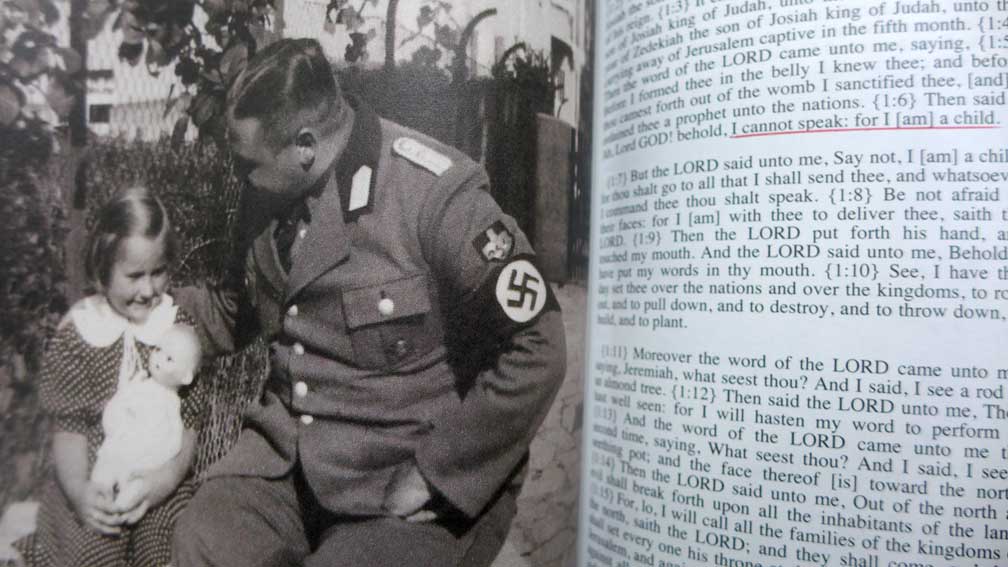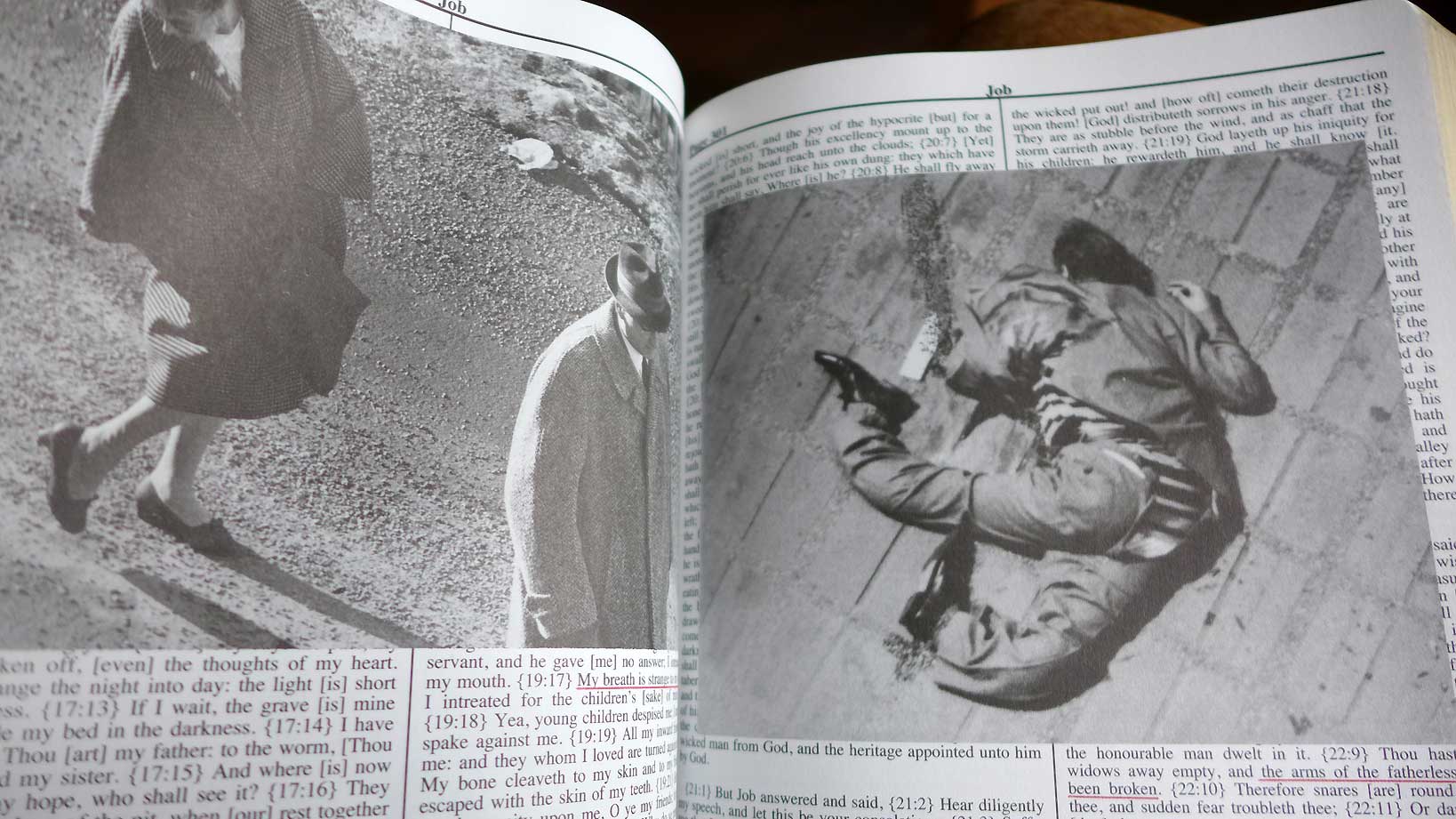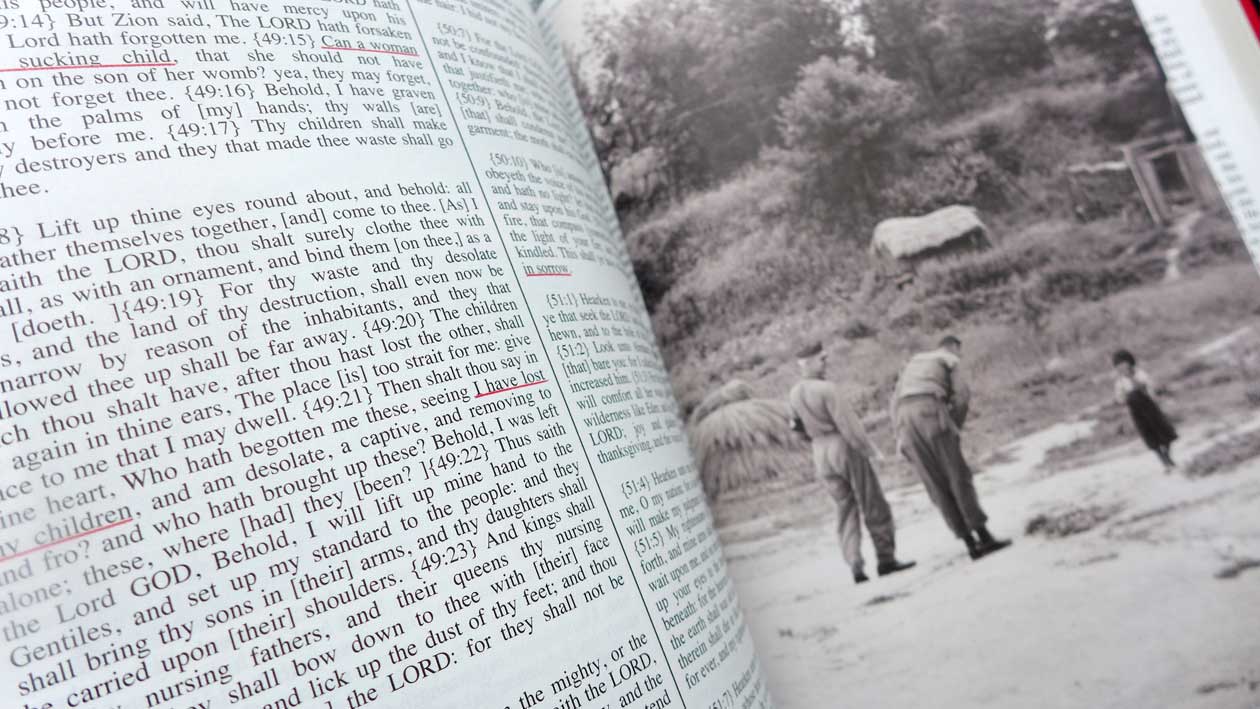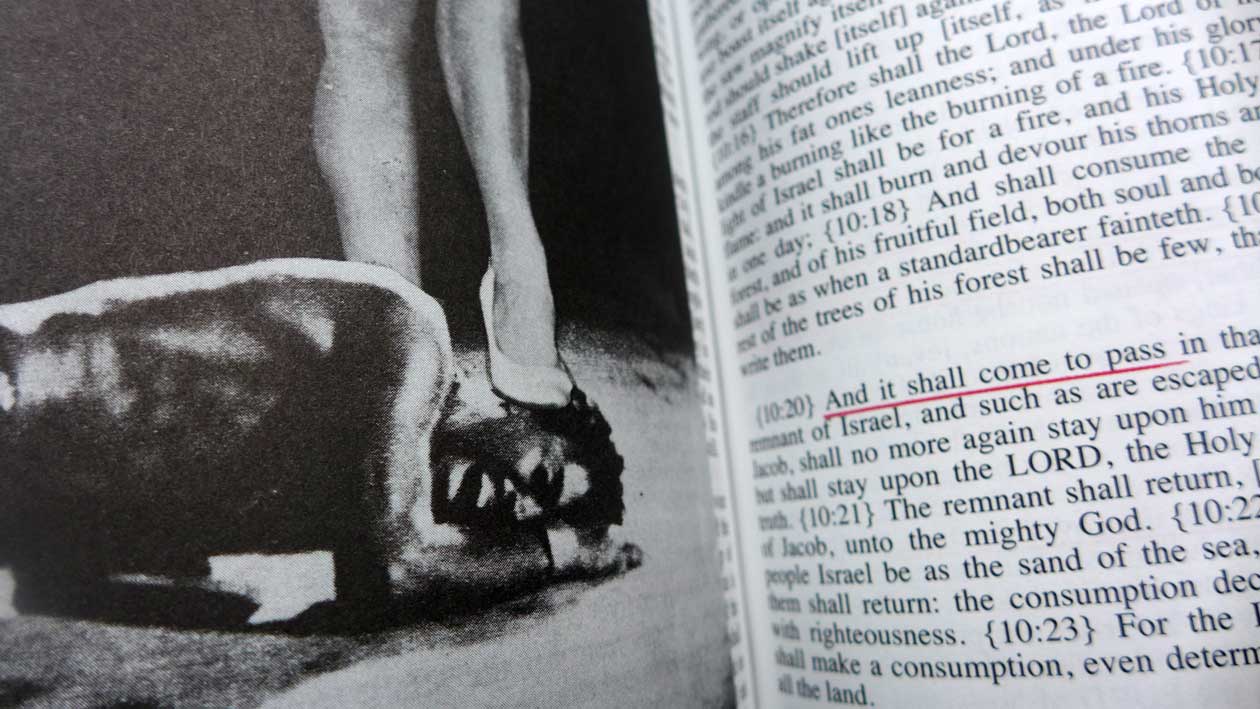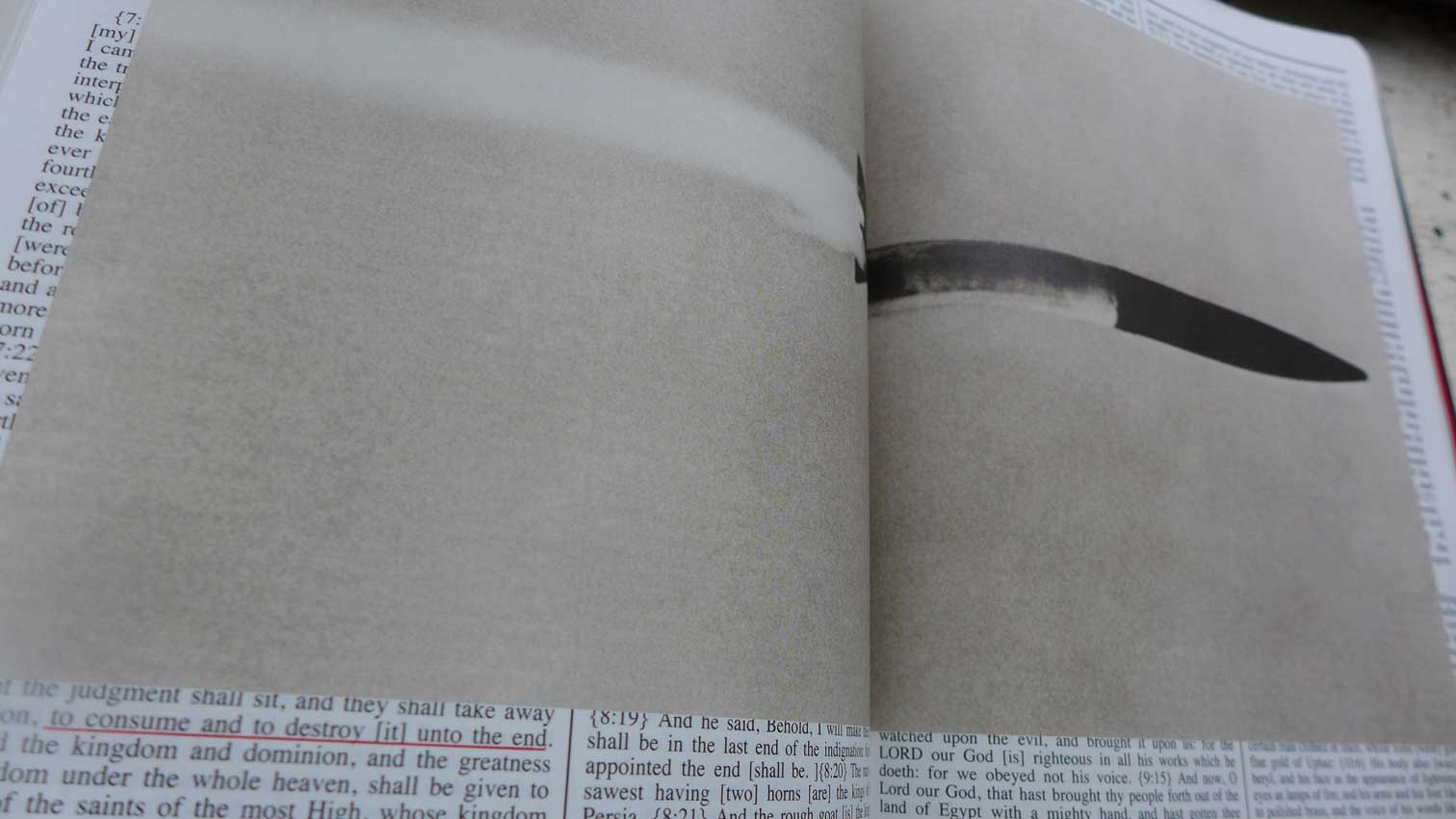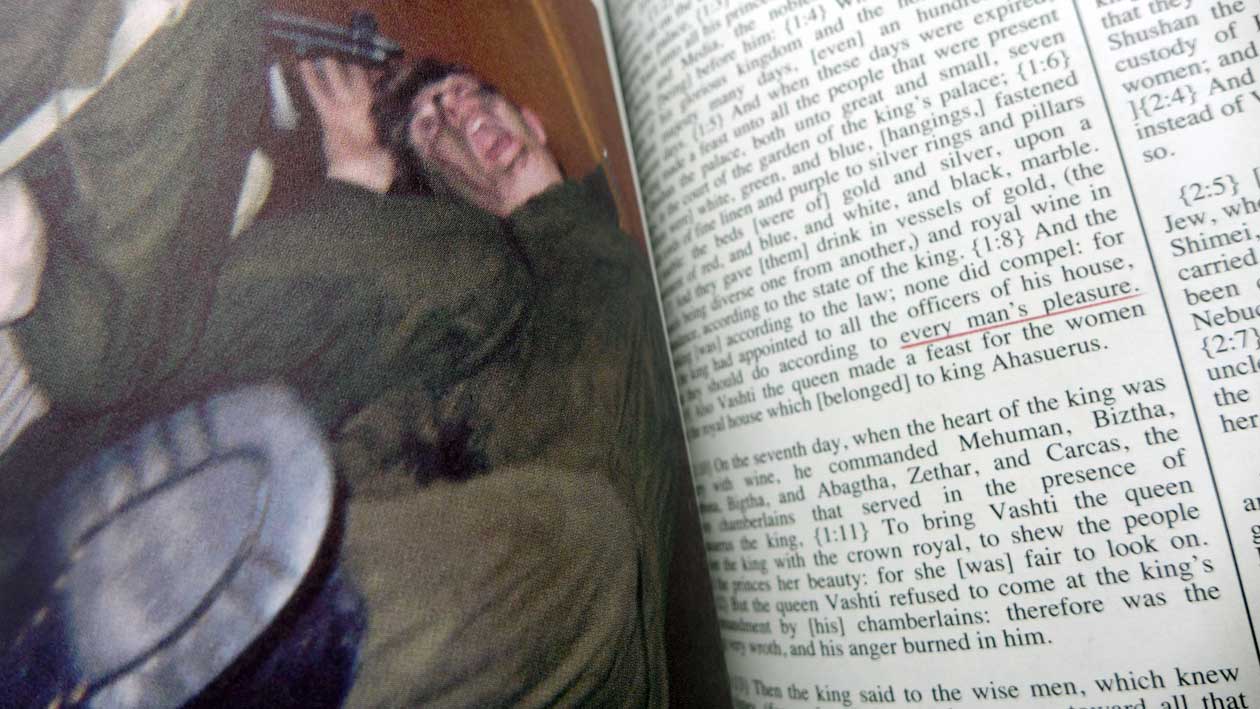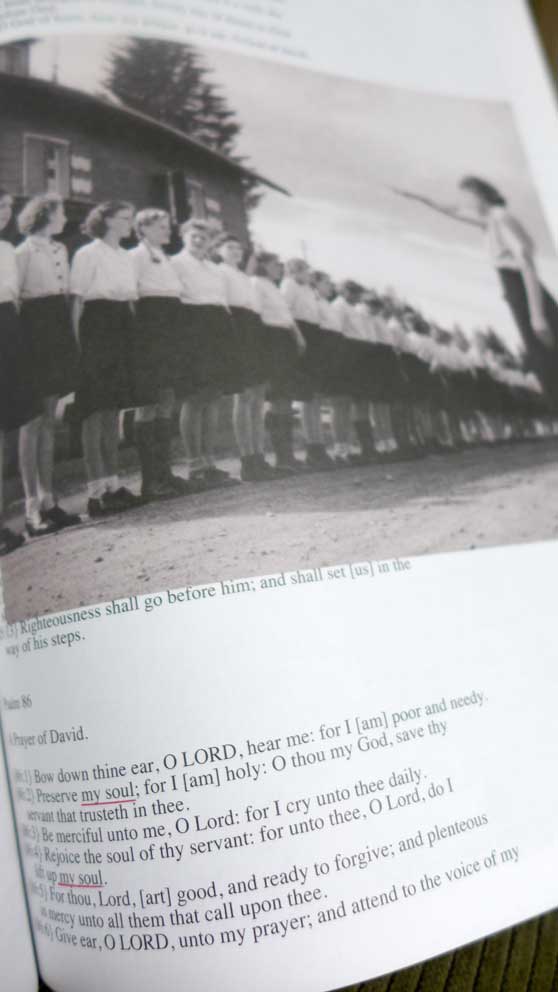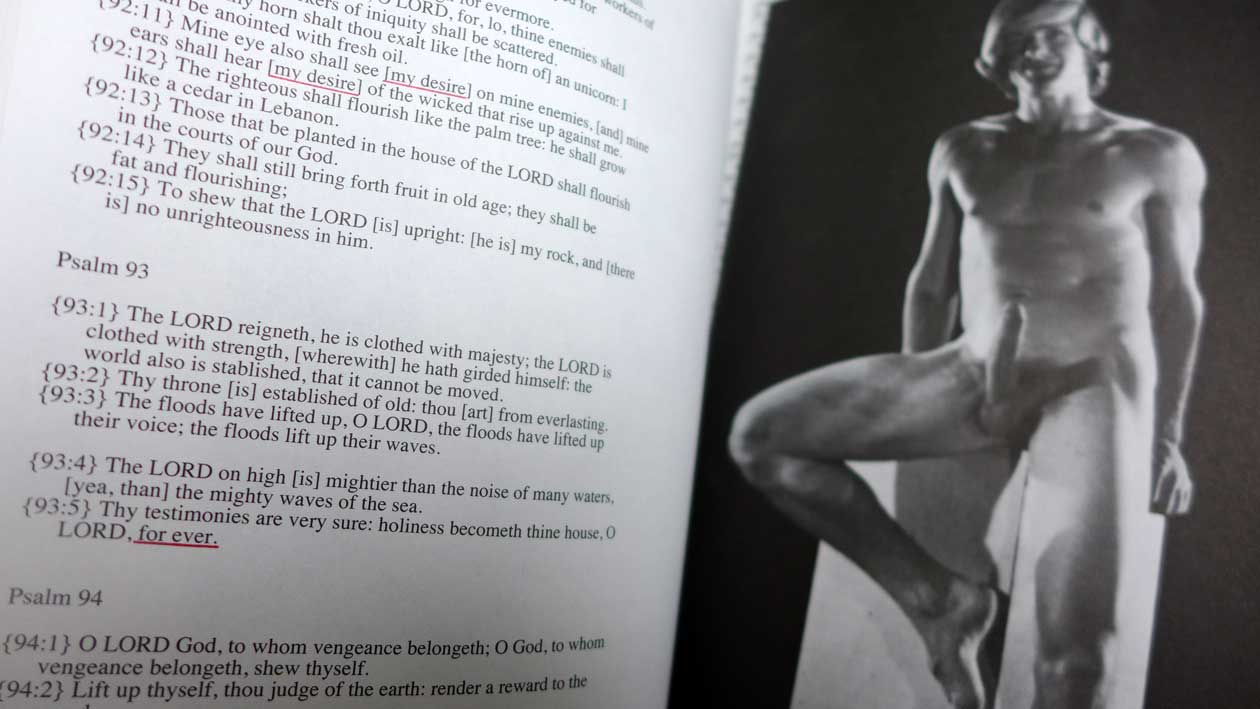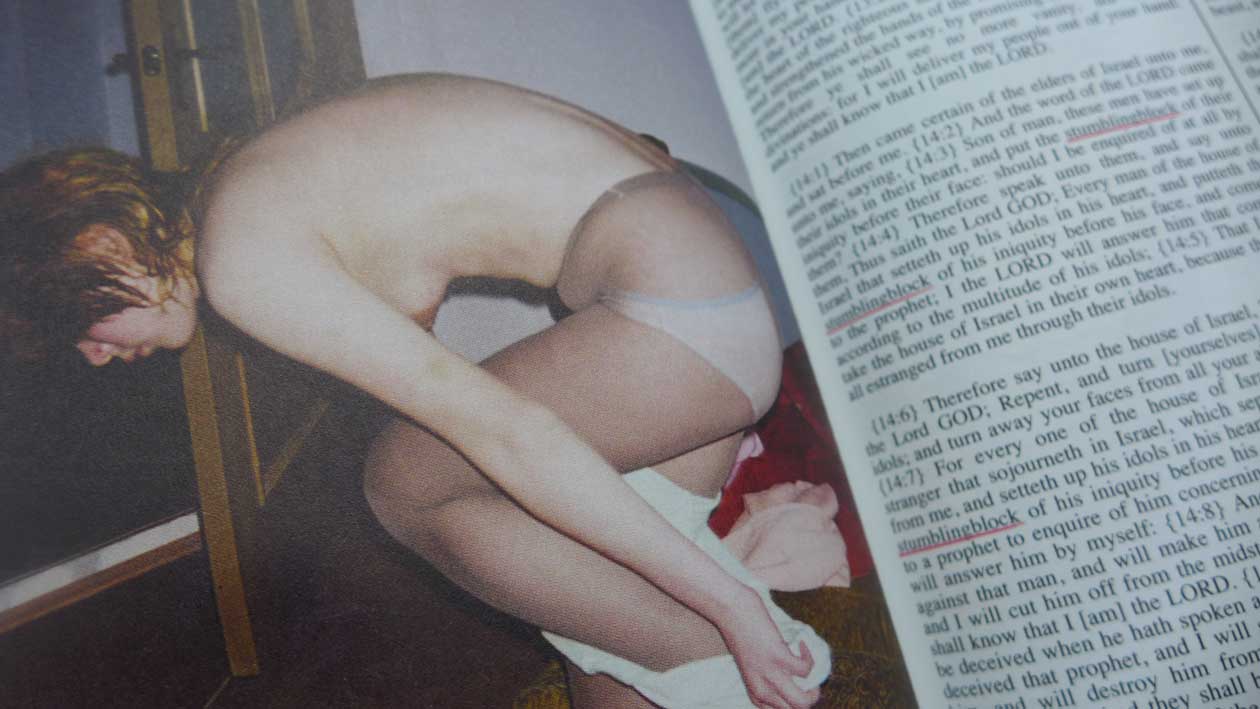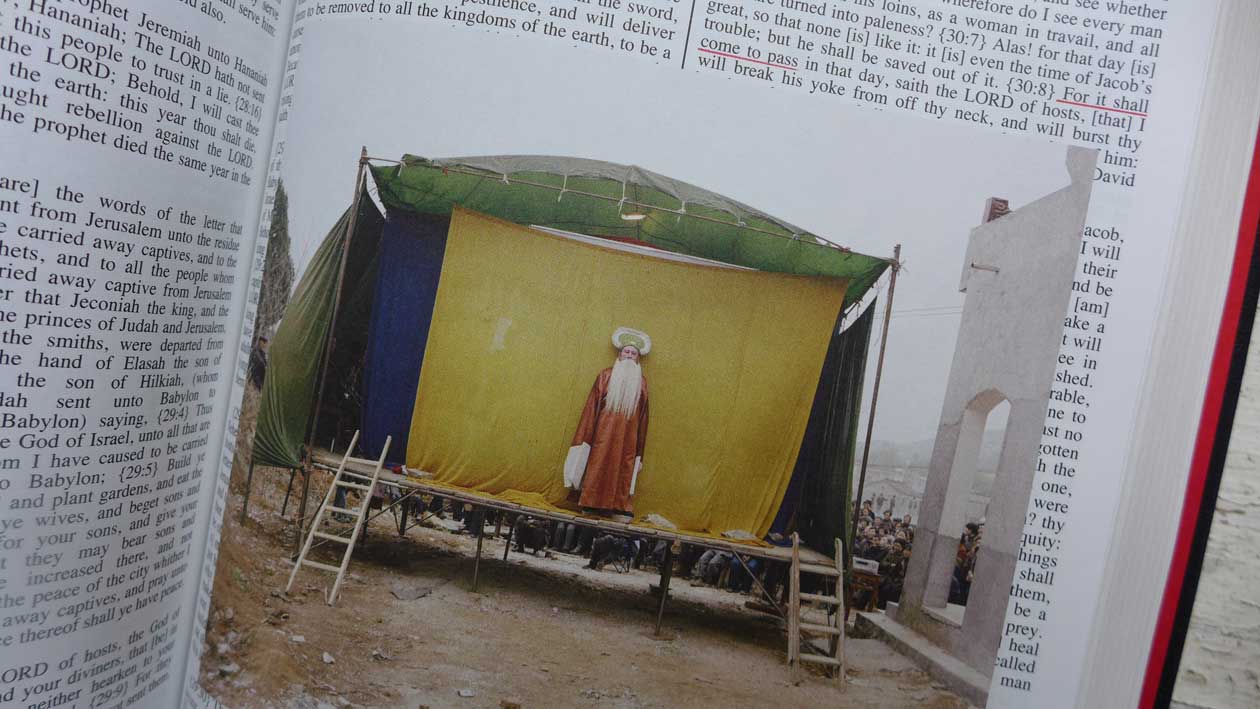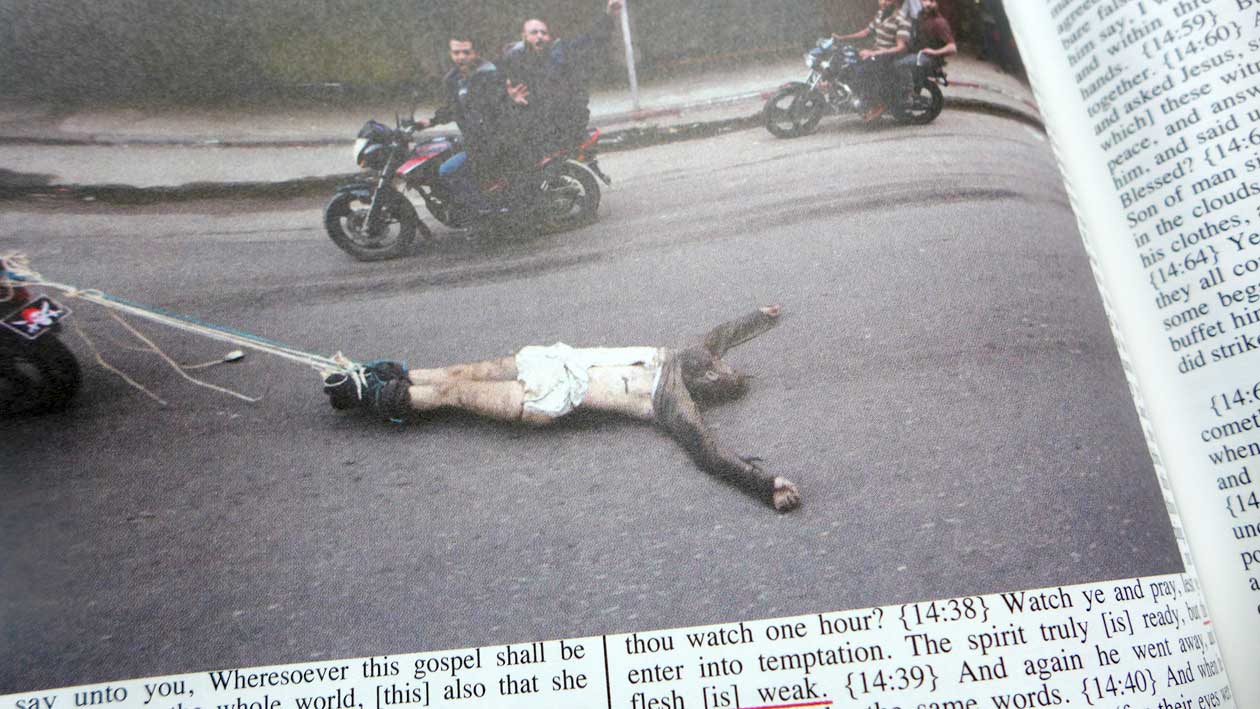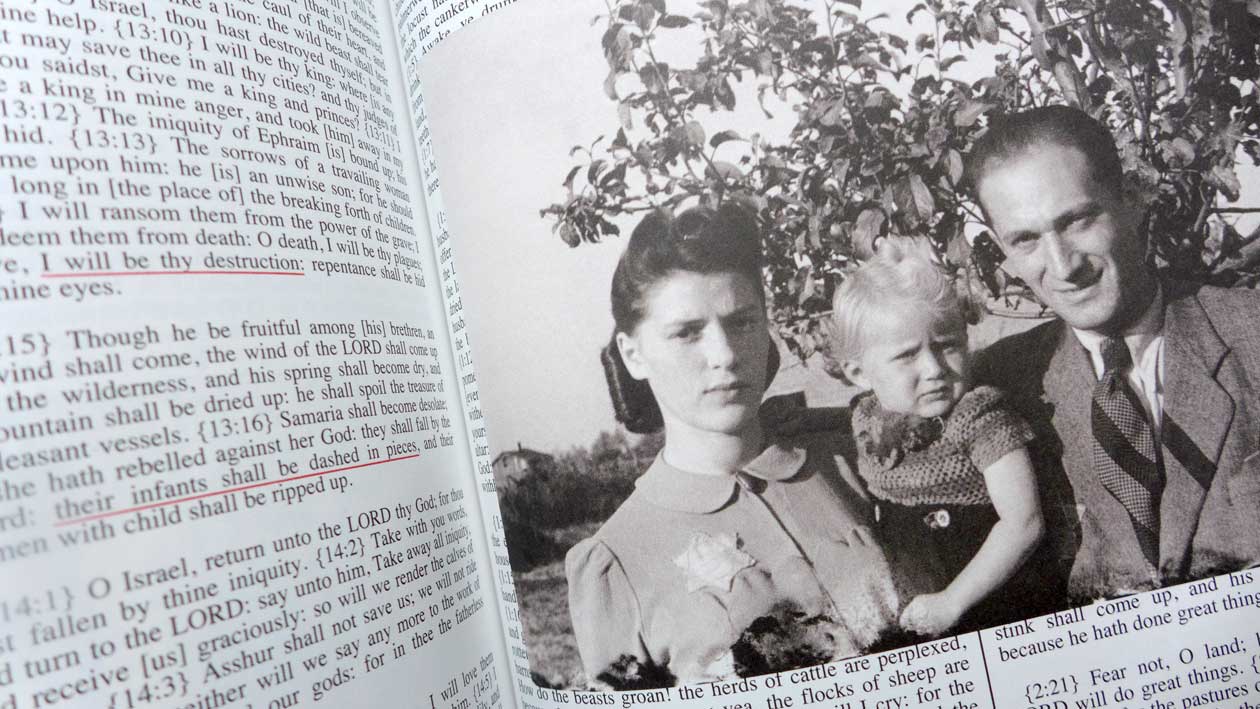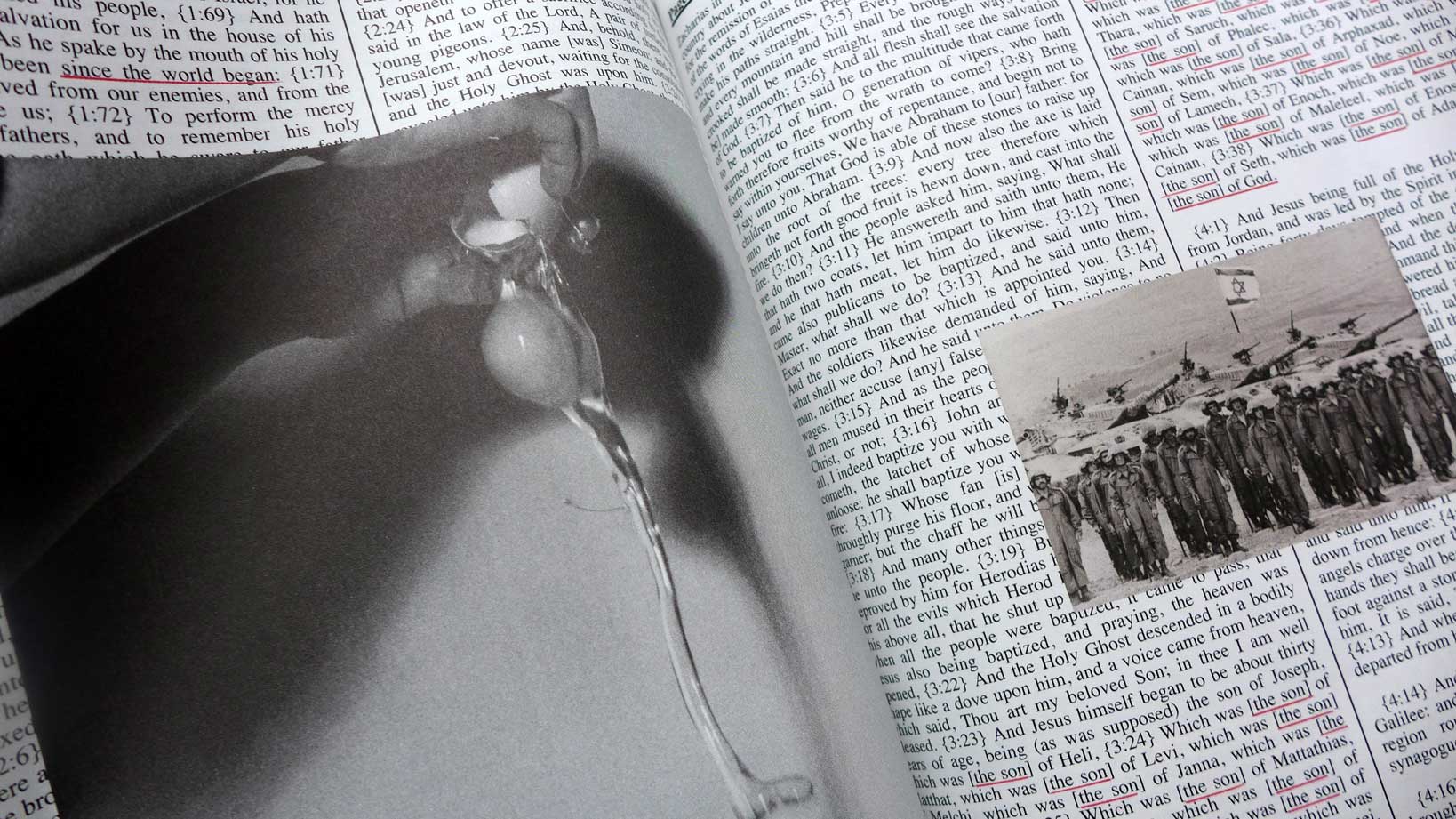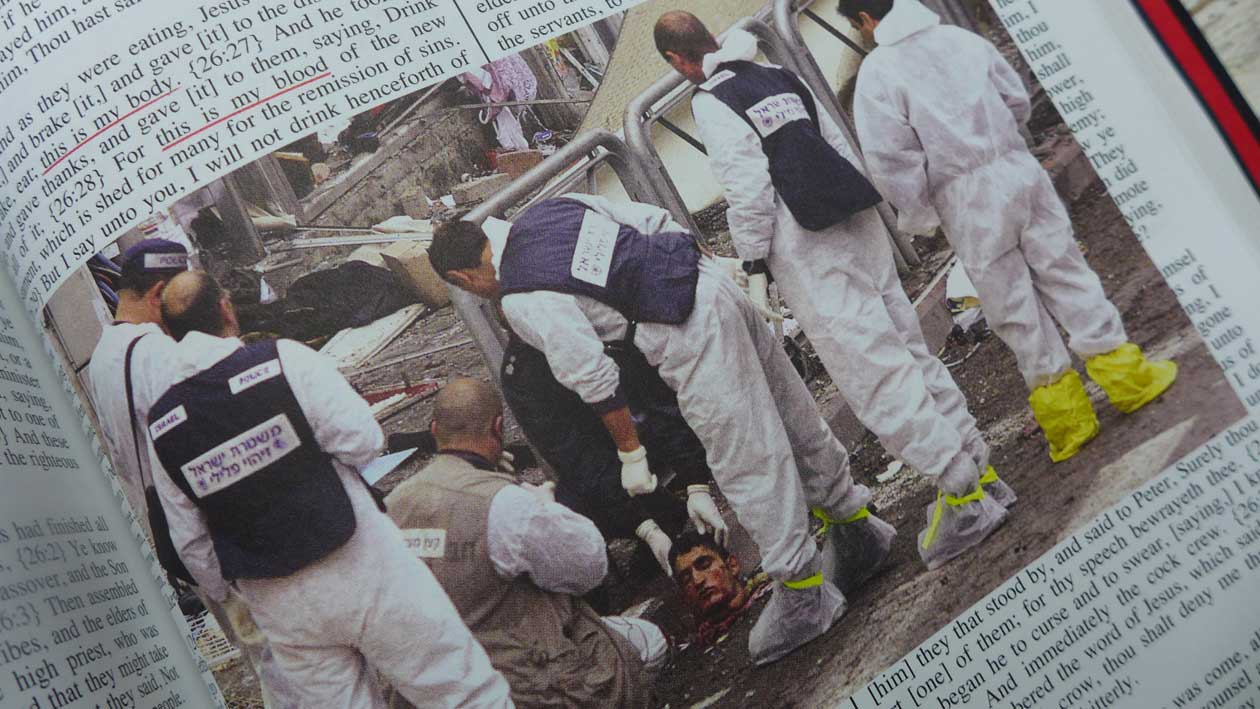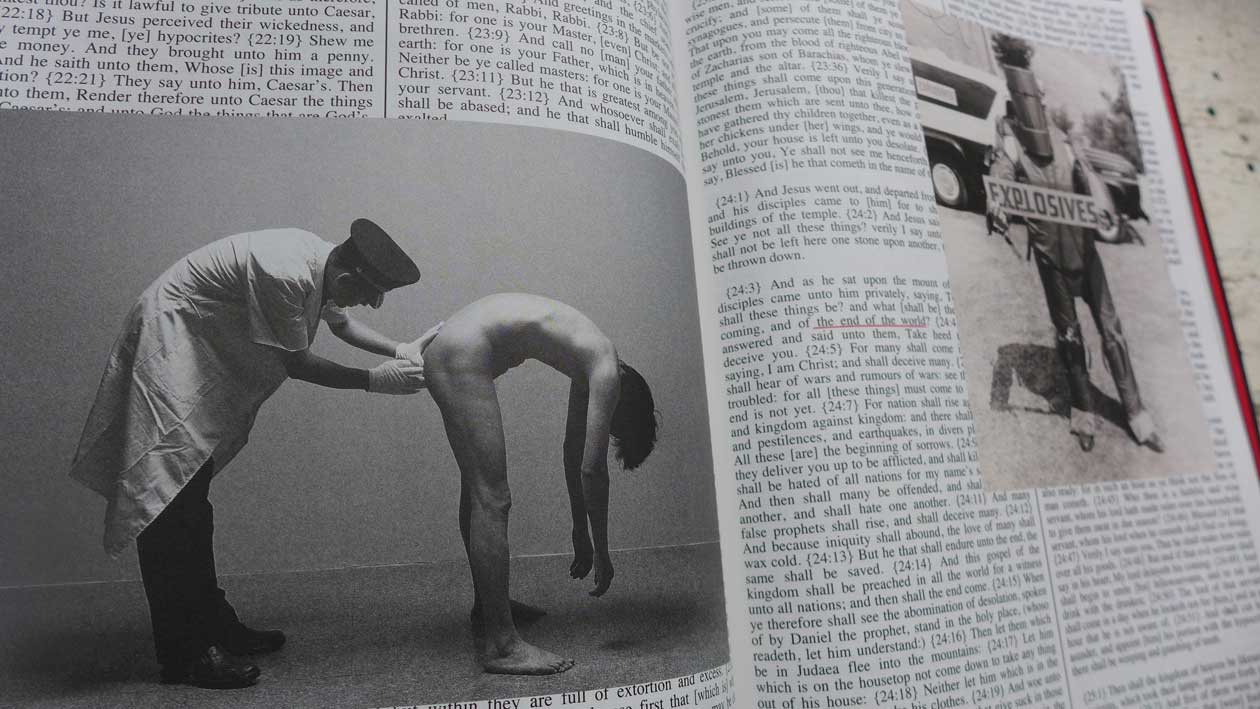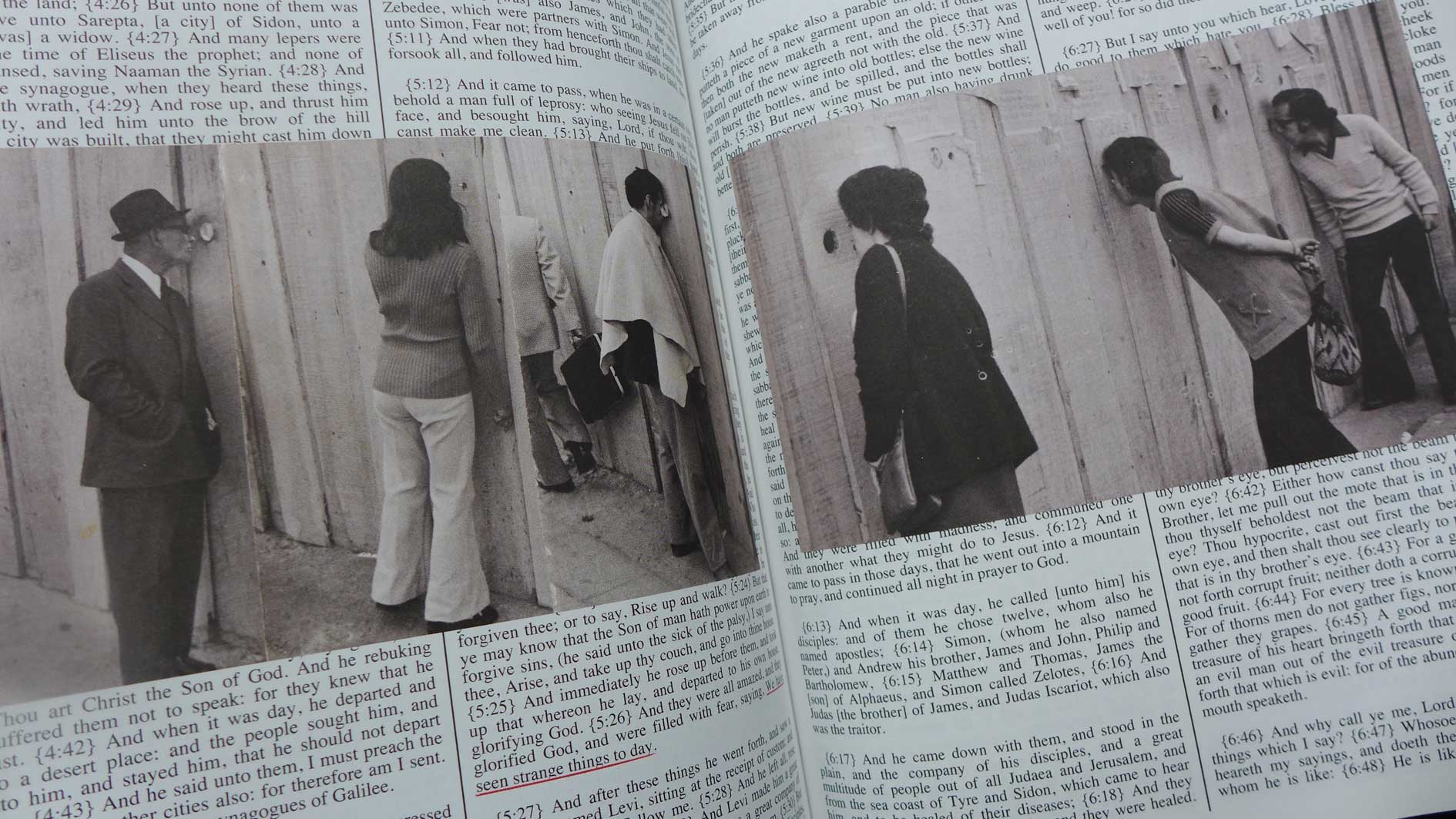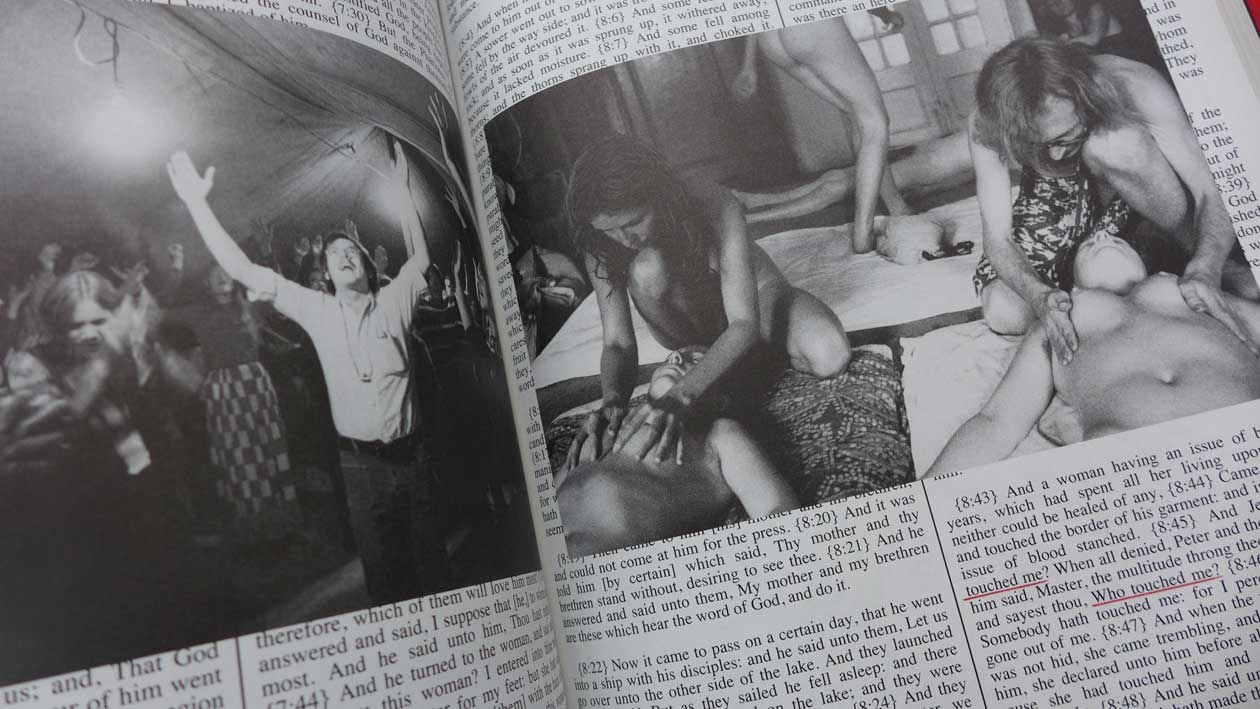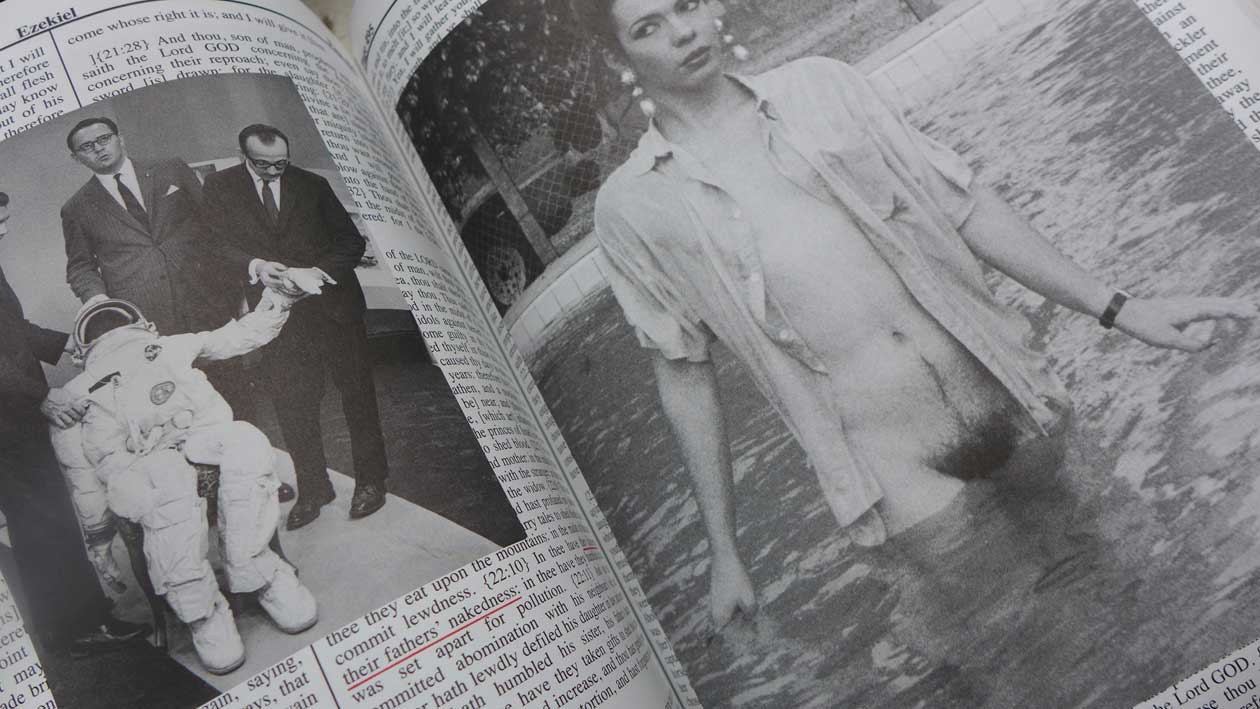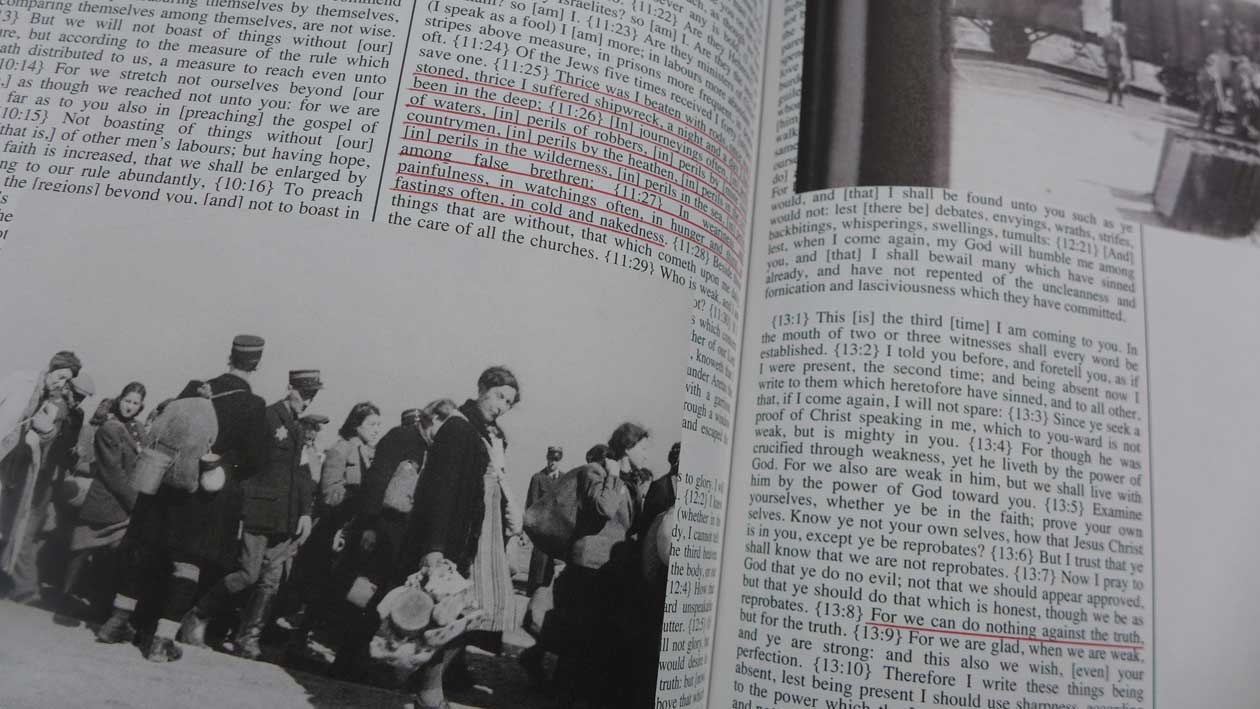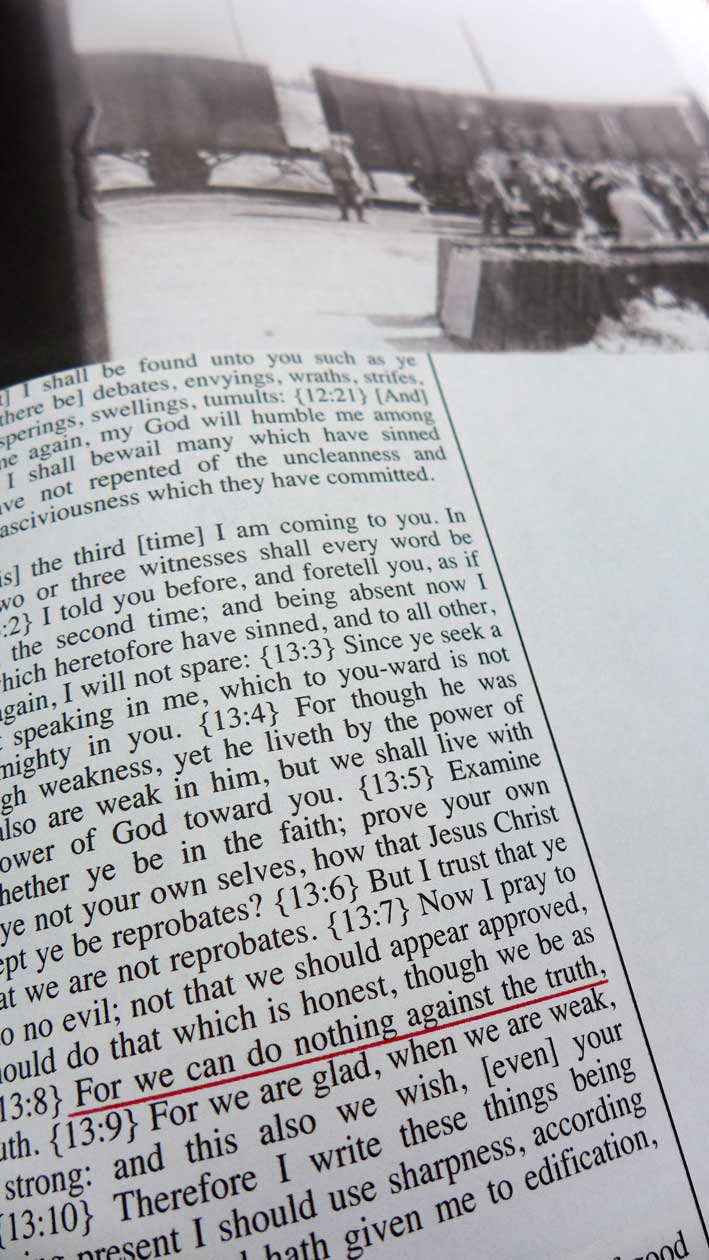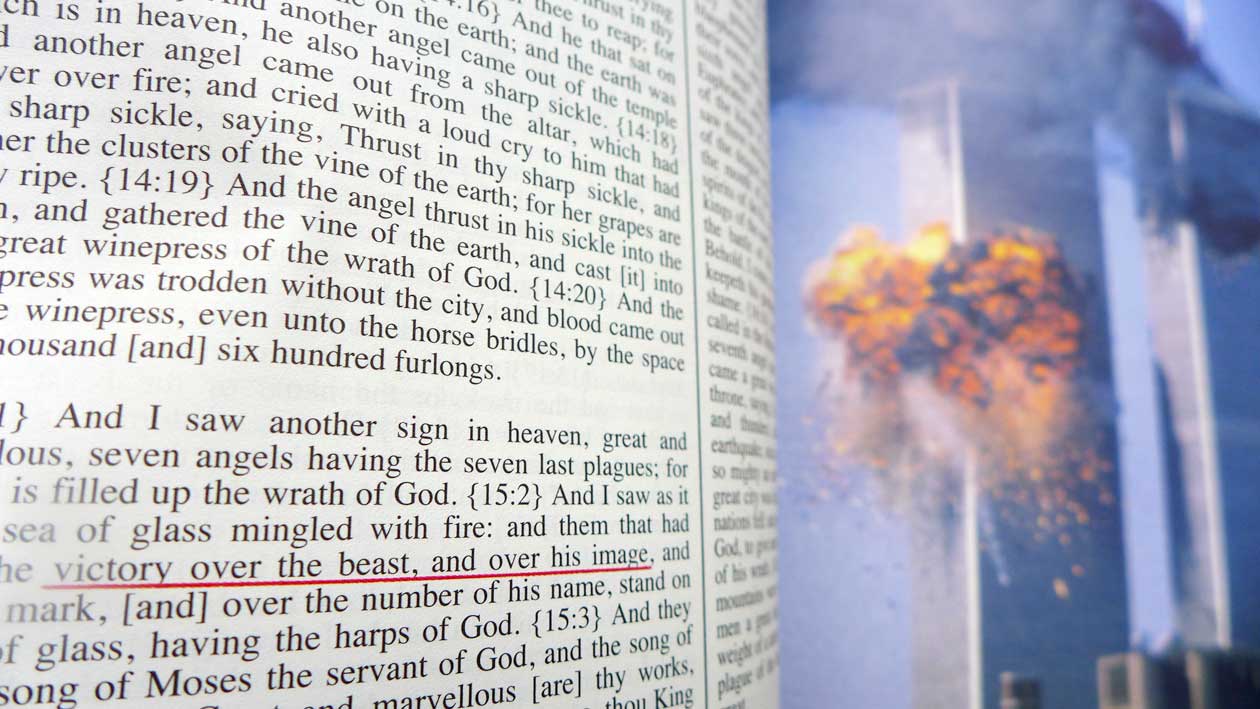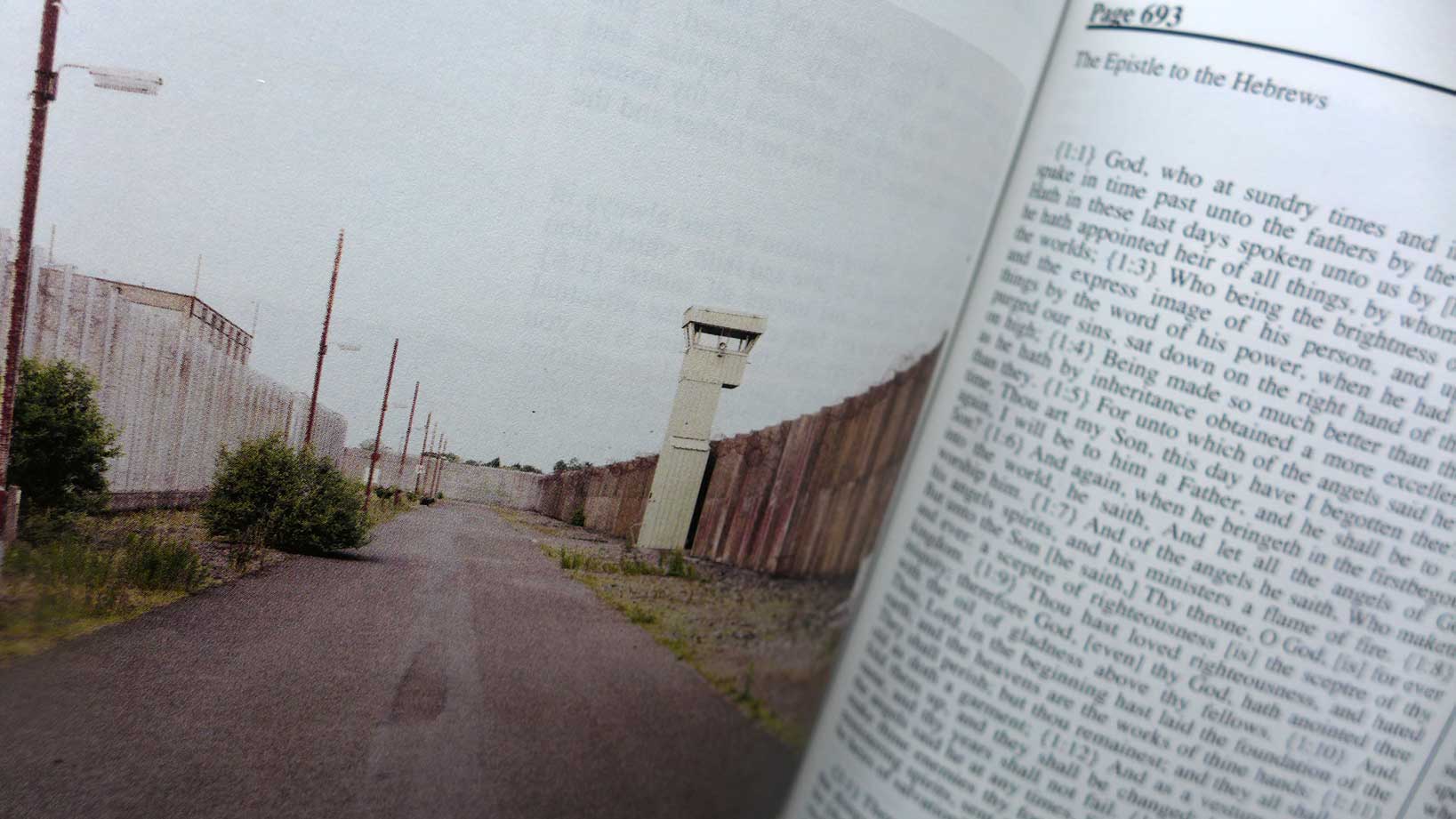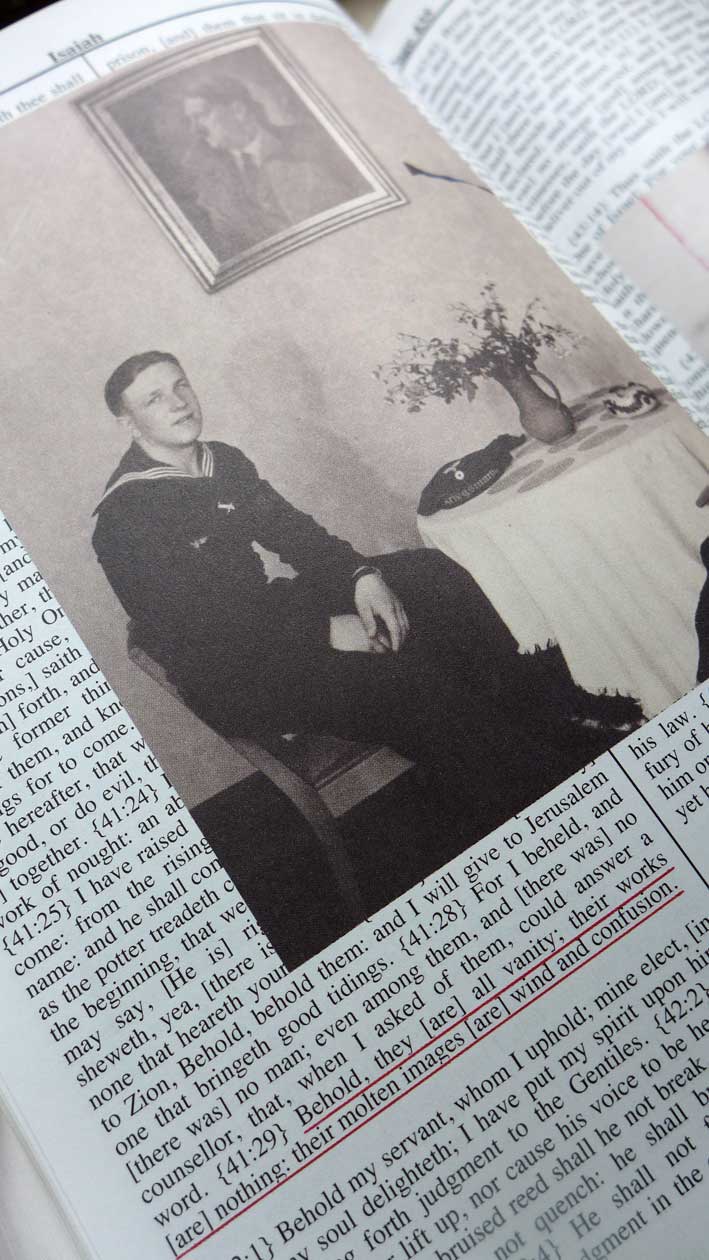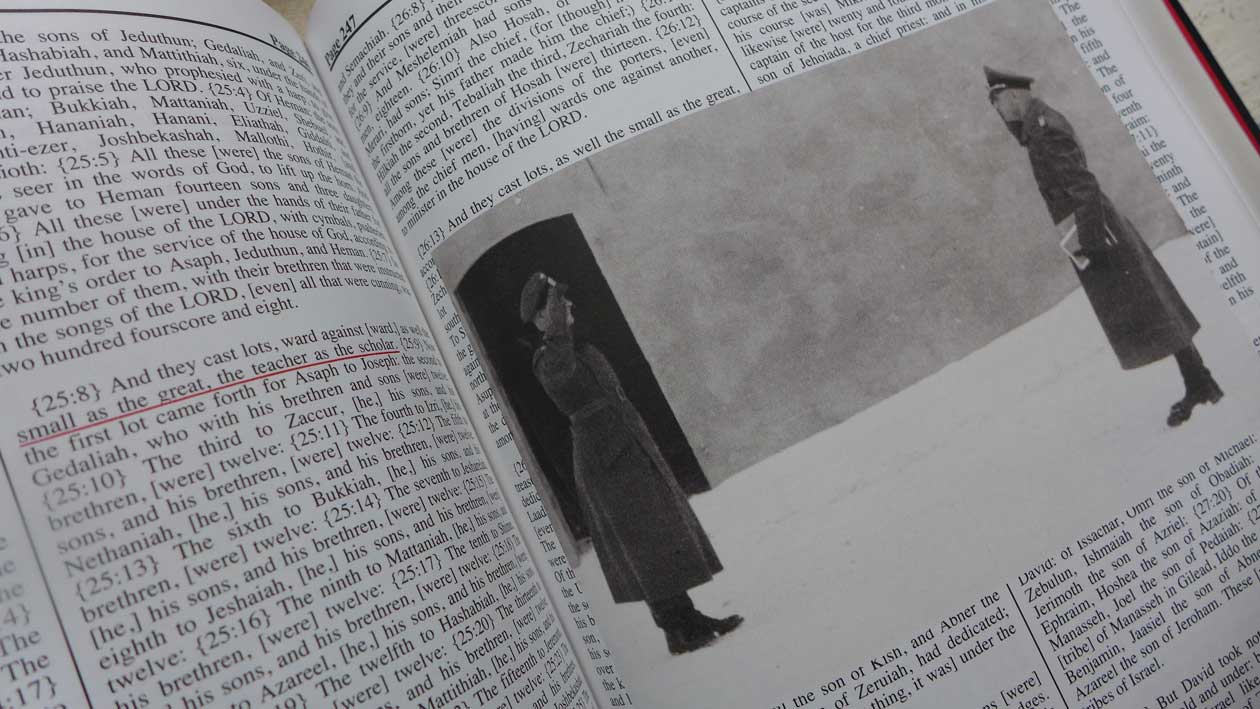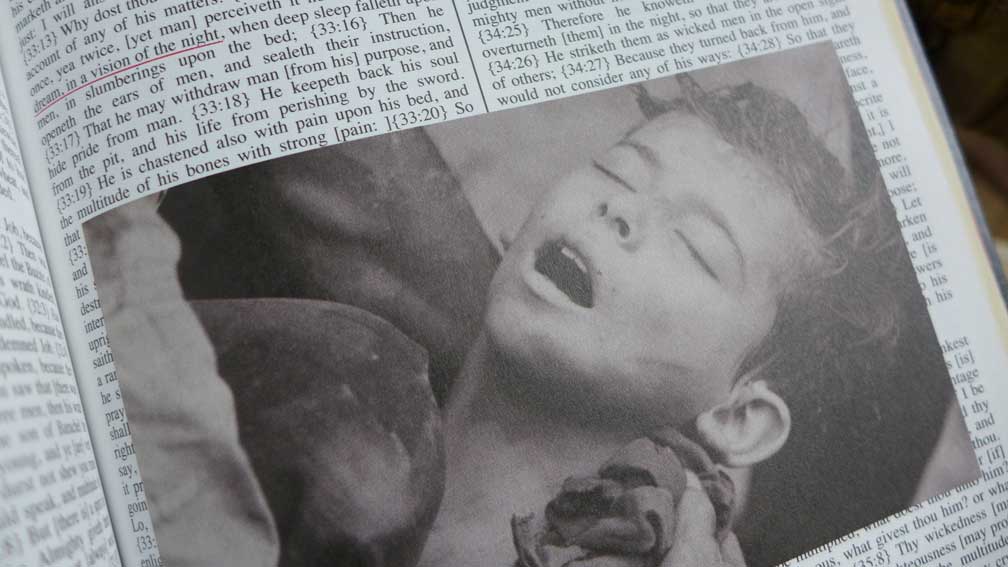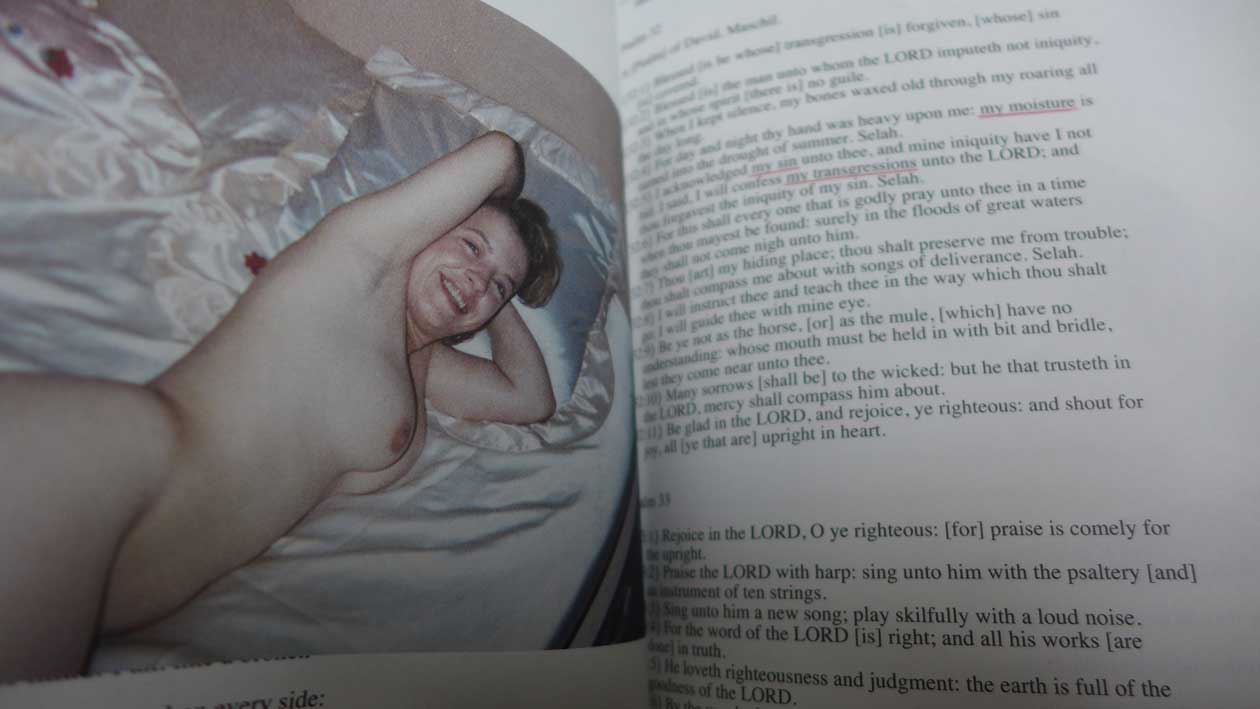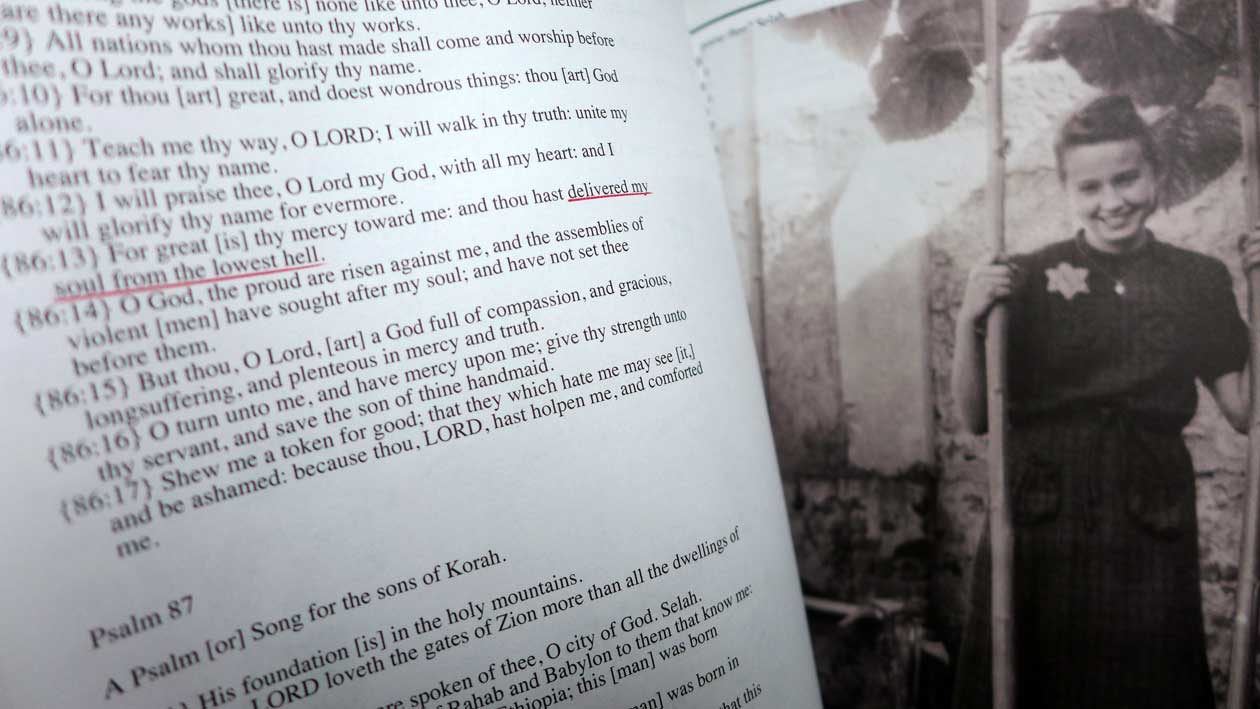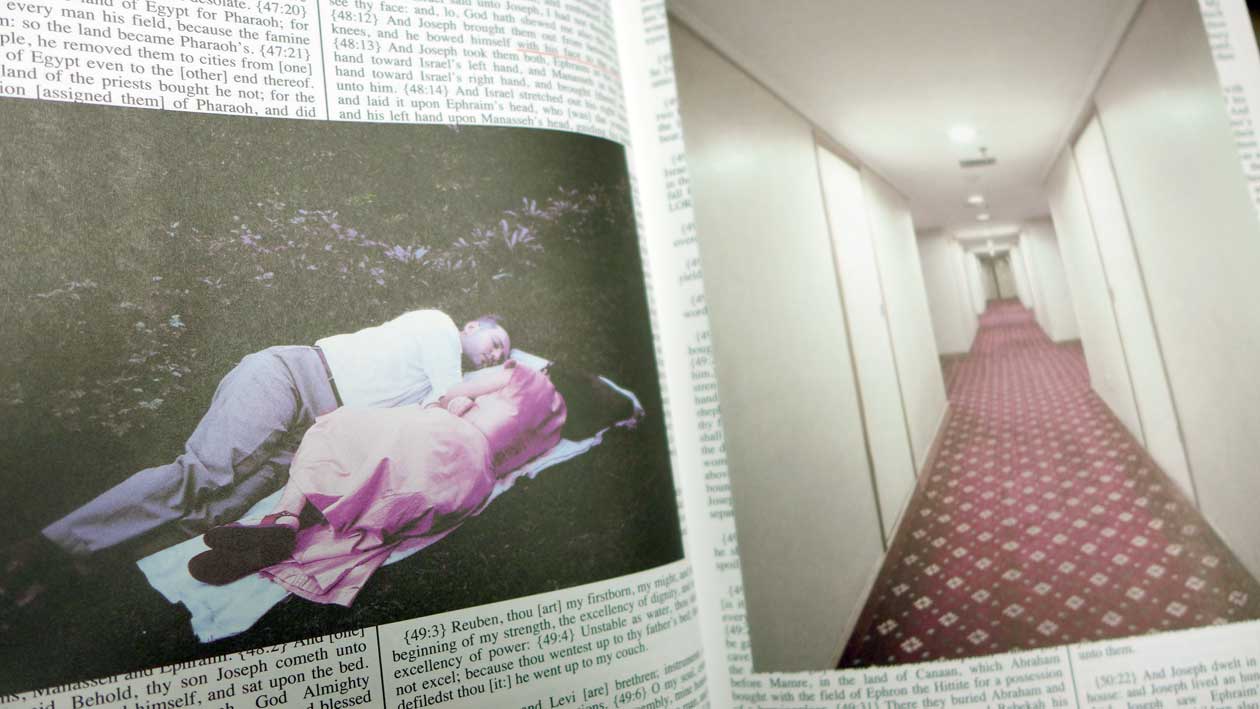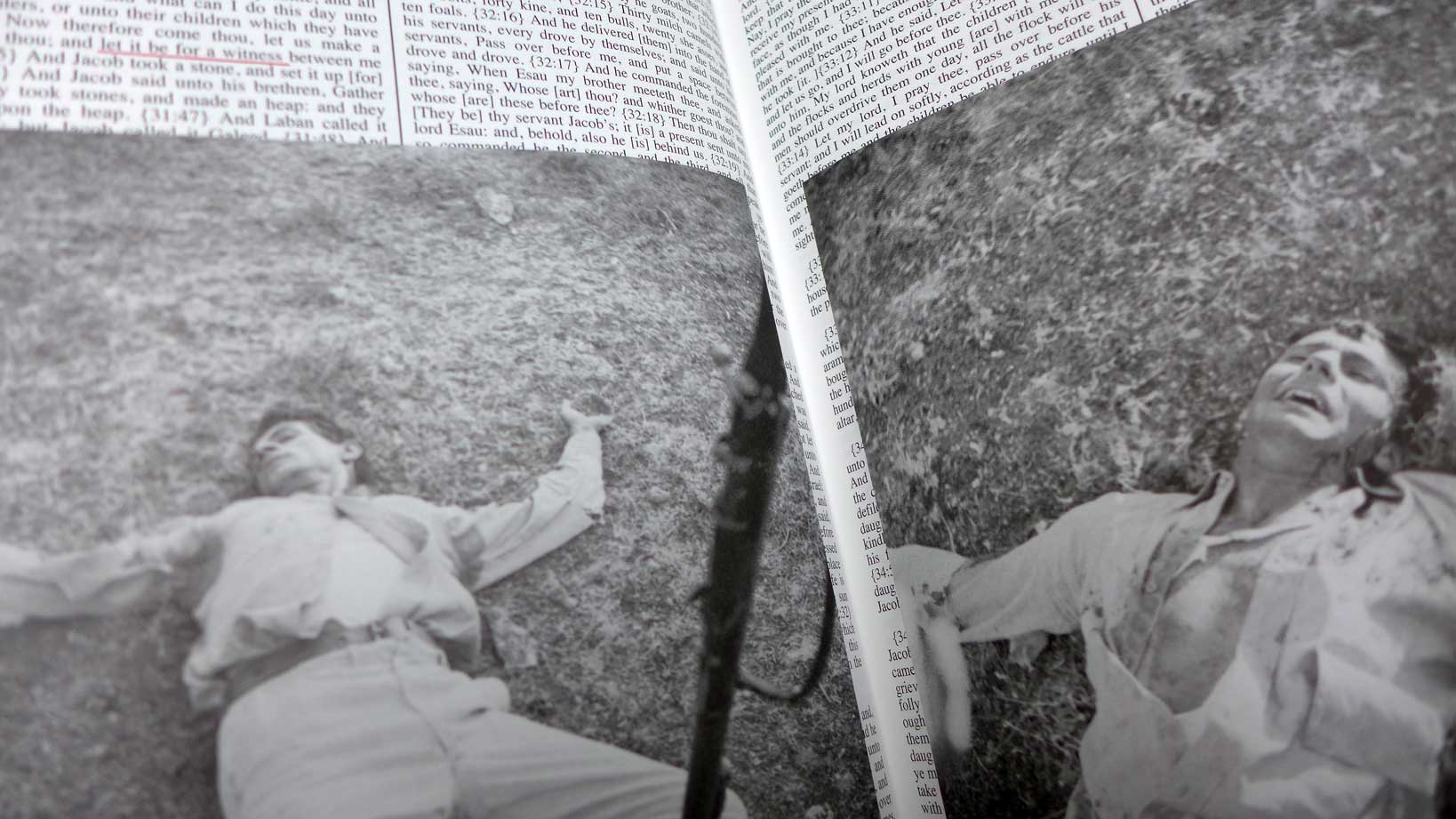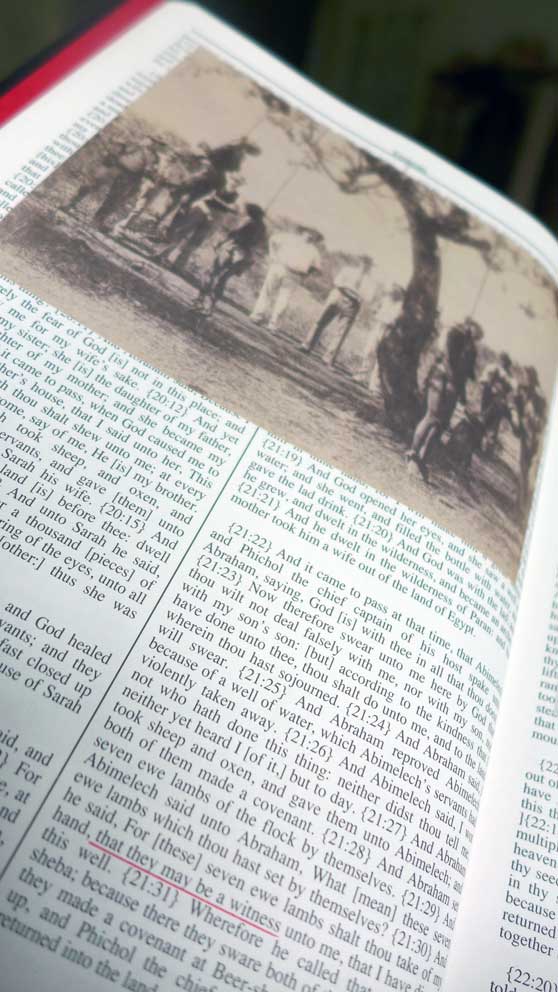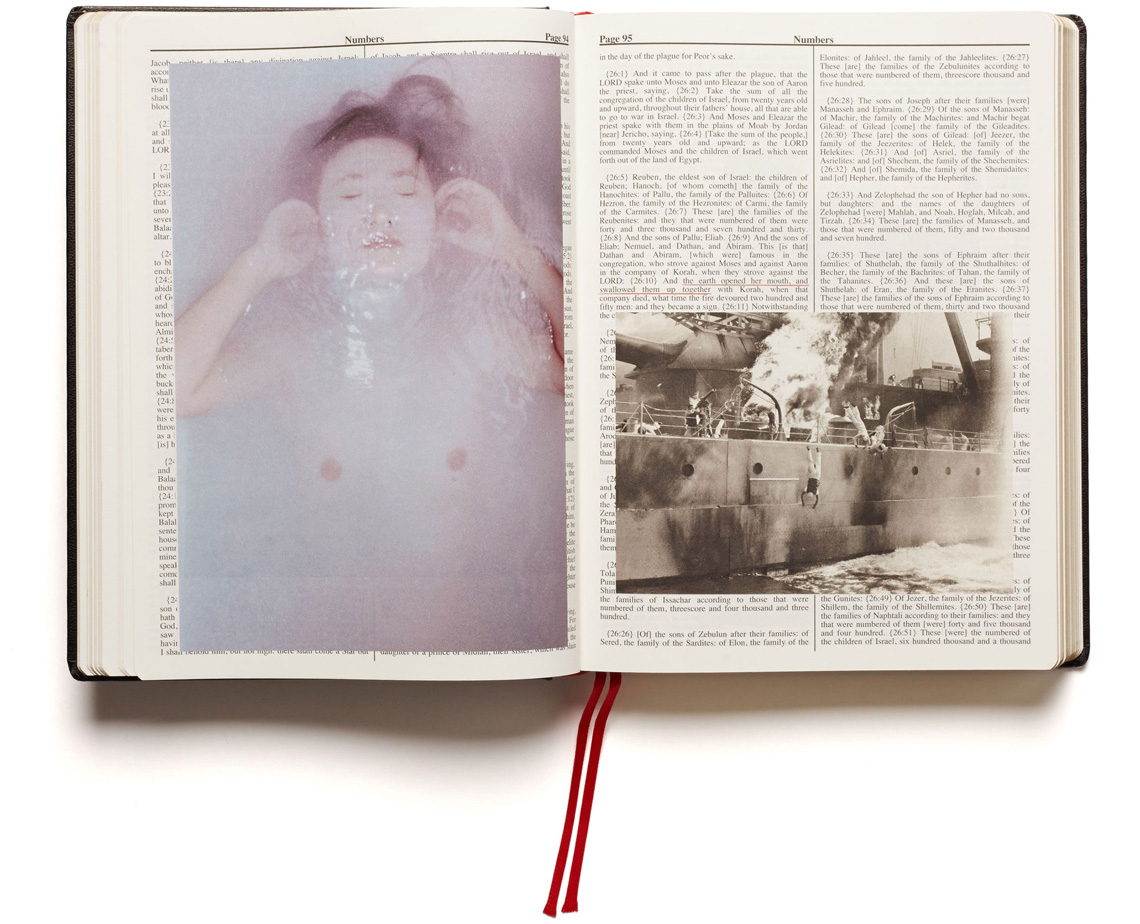Violence, calamity and the absurdity of war are recorded extensively within The Archive of Modern Conflict, the largest photographic collection of its kind in the world. For their most recent work,
, Adam Broomberg and Oliver Chanarin mined this archive with philosopher Adi Ophir’s central tenet in mind: that God reveals himself predominantly through catastrophe and that power structures within the Bible correlate with those within modern systems of governance.
The format of Broomberg and Chanarin’s illustrated Holy Bible mimics both the precise structure and the physical form of the King James Version. By allowing elements of the original text to guide their image selection, the artists explore themes of authorship, and the unspoken criteria used to determine acceptable evidence of conflict.
Inspired in part by the annotations and images Bertolt Brecht added to his own personal bible, Broomberg and Chanarin’s publication questions the clichés at play within the visual representation of conflict.
It’s a common reflex. Very human. Whenever something horrific happens, people tend to turn to God in disbelieve and ask themselves: “Where was he?” Unable to comprehend what can’t be put in words. Atrocities so cruel, they surpass all imagination. The Nazi Genocide of the Jews, the atomic bomb or the attack on the World Trade Center: “How could God let that happen?” A question implying that maybe God sometimes is not present for a brief moment. On the other hand: How could an almighty God not be aware of everything happening on earth he created? Unable to find answers and having their faith put to a hard test, people try to make sense of the unspeakable.
But according to Israeli philosopher Adi Ophir it’s precisely in catastrophic events that God manifests his presence. In his essay “Divine Violence” at the end of the new book
and the AMC), he opens with the following words: ”Right from the start, almost every appearance he made was catastrophic.”
The two artists chose the “Holy Bible” to illustrate Ophir’s point. Black cover, and the title imprinted in golden letters: From the outside the book resembles a normal copy of a King James’ version of God’s word. Yet inside, Broomberg and Chanarin have created a horrifying testimony of what mankind has been capable of. It’s a visual journey through the darkest moments of recent human history.
Broomberg and Chanarin overlayed the original text with images and paired them with phrases underlined in red. By allowing elements of the original text to guide their image selection, the two artists explore themes of authorship, and the unspoken criteria used to determine acceptable evidence of conflict.
Just a few examples of these skillful juxtapositions: On page 719 Broomberg and Chanarin placed an image of the second plane crashing into the World Trade Center on September 11th, 2001. Highlighted next to it are the words: “Worship the beast and his image.” On another page one can see a marine soldier posing underneath a picture of Adolf Hitler hanging on the wall: “Behold, they are all vanity; their works are nothing; their molten images are wind and confusion.” The photos come from the London based
(AMC).
Very often the cruelties were committed in the name of a state or particular government. Violence as a means to defend a certain institutional order or set of values. Ophir writes: “On the one hand, the state has become a potential or actual generator and facilitator of large-scale disasters, and the destructive power of some states has been brought to perfection. On the other hand, the state has also become a facilitator, sponsor, and co-ordinator of assistance, relief and survival in times of disaster. In both cases, the state has taken, or might seem to be taking his role as the chief author of destruction and the ultimate agent of providence.”
The great flow of images – most of them showing atrocities, but every now and then mixed with portraits of clowns and people laughing – creates a sense of impotence in the viewer. Taken out of context and put together in a place were one wouldn’t expect it, they seem random. They leave the observer behind with a sense of helplessness regarding the course of history, entangled in a complex world full of conflicts and events man is incapable to decipher.
Inspired in part by annotations and images German writer Bertolt Brecht added to his own personal bible, Broomberg and Chanarin’s publication questions the clichés at play within the visual representation of conflict. In this context one can’t help but think of what US-philosopher Susan Sontag wrote in her essay
in which she discusses two fundamental ideas regarding the role of photography – which may seem contradictory. On the one hand Sontag mentions the so-called “CNN effect”, referring to the power of images, especially documenting atrocities of all kinds, to mobilize people and causing a reaction in the observer.
On the other hand Sontag says that we live in a world “ultra-saturated with images”. Even being very strong, they still lose impact. Because of the vast amount of images circulating in today’s mass media, visual stimulation has lost its power. The ability to react to such a flood of images has decreased: one either becomes cynical and bitter at the obvious display of so much evil in the world – or indifferent. Sontag advises: “To make peace is to forget. And for reconciliation it’s necessary to accept that memory is faulty and limited.”
Whether Broomberg and Chanarin have also thought of Sontag’s words or not when putting together their latest book, they raise the same fundamental questions as to the use of photography – and how we position ourselves facing a chaotic world full of contradictions and its visual evidence. It’s not a typical photography book Adam Broomberg have put together. It’s deeply disturbing, artistically well done and highly thought-provoking. Highly recommendable. -
Without wanting to spend too much time on this point, it might be worthwhile to realize that when assessing artistic merit there is quite a bit to be gained from not being overly guided by one’s own preferences. Having said that, I have been following Broomberg and Chanarin for quite a while now, and I am always looking forward to a new body of work. I am very much interested in the use of photographs, and I am interested in investigating the political power images have or how power is created when images are being used. What distinguishes Broomberg and Chanarin from many (if not most) other artists working in this vein is the high quality of their output, regardless of whether that quality then translates into artistic merit (which is, of course, entirely subjective – unless we wait one hundred years, in which case we could take what is still being looked at as that, which has the highest merit).
It might seem weird to preface a photobook review the way I just did. But I do think it’s important for me to state where I’m actually coming from. What is more, we have come to embrace the idea that an artist should be measured by previous bodies of work – an approach that creates all kinds of problems (unless an artist wants to literally repeat what s/he has been doing ad infinitum, the art world’s surprisingly popular version of Nietzsche’s concept of the eternal recurrence of the same). If an artist’s later project is not the same as some earlier one, then we should judge it on its own artistic merits and not on whether it looks like the previous – or a very famous earlier – one.
On top of that, there are many photographs of magicians (or circus acts) linked to “it came to pass.” Those images are just amazing, given how they subversive they are in their utter ridiculous playfulness. In fact, the magicians are much more subversive than the violent images linked to violent text. Here we have Broomberg and Chanarin asking whether power, religious or political, isn’t essentially just an act of trickery, a trickery that requires considerable skill and, crucially, the audience’s willingness to ignore the knowledge that it’s just trickery, not real magic.
Highly recommended.-
Conscientious Photography Magazine
Adam Broomberg and Oliver Chanarin
by Sabine Mirlesse
 Ghetto, Rene Vallejo Psychiatric Hospital, Cuba, 2003, C-Print, 16 x 12 Inches. Courtesy of the artists.
Ghetto, Rene Vallejo Psychiatric Hospital, Cuba, 2003, C-Print, 16 x 12 Inches. Courtesy of the artists.
When
I arrived in London this past September to meet Adam Broomberg and
Oliver Chanarin at their studio, the first thing we discussed was the
power play between interviewer and interviewee. We had to decide what
kind of conversation we would have—serious or funny, formal or informal,
and how self-conscious? We agreed that we wanted a bit of all of that
and for the next two hours we talked about many things: how they
function as a duo, their distrust of power, whether there’s a necessity
to explain the details behind their work, and what they envision on
their tombstones.
The two South African artists have been working
together for more than a decade. After starting out as magazine
photographers, they moved on to other innovative ways of addressing the
use and abuse of pictures as well as dynamics of authority through
installations, curatorial projects, and books. Their work has been
exhibited widely—in solo exhibitions at the Stedelijk Museum in the
Netherlands and the Jumex Foundation in Mexico, among others—and will be
on view at the Tate Modern this winter as part of the
Conflict, Time, Photography exhibition. They were awarded the ICP Infinity Award 2014 for their publication
Holy Bible.
The
two artists are self-deprecating enough to call themselves "two
goofballs," but behind the jest is a sober inquiry into the tragicomedy
of life and a poetic kind of button-pushing in the hope of setting off
some alarms. In the words of Lewis Carroll, whose Dodo in
Alice in Wonderland
gave the title of their most recent project: "There is a place, like no
place on earth. A land full of wonder, mystery, and danger. Some say,
to survive it, you need to be as mad as a hatter. Which, luckily, I am."
Luckily, Broomberg and Chanarin are, too. The best people usually are.
— Sabine Mirlesse
Sabine Mirlesse How did you meet one another?
Oliver Chanarin It was a dark, dark night.
SM Is that how you guys were conceived?
Adam Broomberg We're actually cousins and we only discovered that after fifteen years of working together.
OC
We come from the same shtetl in Lithuania. So it's not that surprising.
We met in South Africa in our early twenties in a place called
Wuppertal—a little missionary town.
AB
Population of about four people, and us. Olly lived in London since he
was seven, and then I left South Africa and came here to study at Saint
Martin's.
OC He called me up and
said, "I've just inherited this IKEA bed from my brother but I don't
have a screwdriver." So I brought the screwdriver ‘round and that was
the beginning of our collaboration.
SM So you have an IKEA bed to thank?
AB Yep. We became friends many years before we started working together.
OC Adam dropped out of college and went to work at Fabrica.
AB
I was part of the first generation at Fabrica, the communication
research center in Italy. It was run by film director Godfrey Reggio who
did the Qatsi trilogy, with music by Philip Glass. Reggio is a
remarkable man. Eventually I was offered to take over COLORS Magazine.
SM So you had to live in Treviso?
AB No, we lived in Venice.
OC
So Adam called me and said, "I know you're severely dyslexic but would
you like to come work on a magazine with me?" And I said yes. I came for
two weeks and it turned into a year—
AB
—which turned into seventeen years. We worked there for a year, molding
COLORS magazine with Oliviero Toscani but we got very disillusioned
with his format for it. So we came back to London, borrowed Olly's
father's camera, set off, and made our first book, which was called
Trust.
Then we were approached by COLORS again; they told us Toscani had left
and asked if we would come back and do whatever we wanted.
SM Was that in 2000, when you did
Ghetto?
AB Yes, we came up with the concept of examining these gated communities around the world.
OC
Although the magazine was radical in the early '90s in the way it
juxtaposed different cultures and described a multicultural global
community that was very new back then, by the time we took over, it was
starting to feel a bit like a tired trick. There was also something
potentially abusive about the way the magazine was using photography.
SM What do you mean by abusive?
OC
Most of the images we were using came from photography agencies and in
ninety-nine percent of the cases we had no connection to the
photographer and the subjects. That distance is potentially abusive—the
photographs become detached from their context, from the people in the
image. The subjects stop being individuals and become part of a visual
or political argument. We wanted to resist that.
AB
So we came up with this formula where we would go to these gated
communities—for example, refugee camps, prisons, and psychiatric
hospitals. We went with our 4x5 camera, always taking a writer who was
not a journalist—often screenwriters or novelists—and we would interview
everybody. We disclosed their real names and kind of upset that one-way
flow of power that is inherent in traditional documentary photography.
One example, which doesn't necessarily work, is that last chapter in the
psychiatric hospital in Cuba. We set up the lights, gave the subjects
the release cable, and said, "Take your
own portrait." But, ultimately, the process, even in that documentary format, started troubling us more and more.
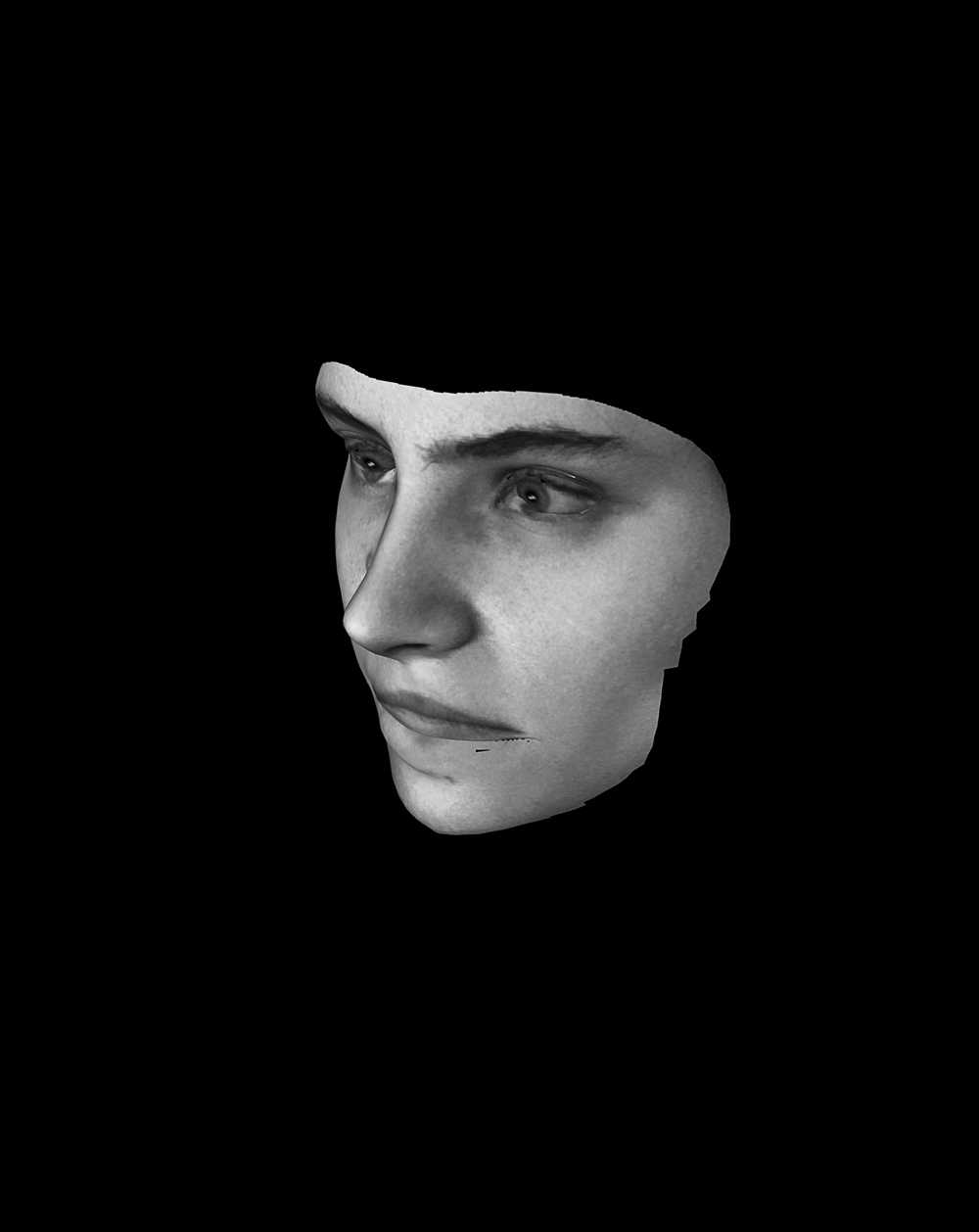 The Revolutionary, Shtik Fleisch Mit Tzvei Eigen,
2013. A series of portraits, which includes Pussy Riot member
Yekaterina Samutsevich and many other Moscow citizens, was created by a
machine: a facial recognition system recently developed in Moscow for
public security and border control surveillance. The result is more akin
to a digital life mask than a photograph; a three-dimensional facsimile
of the face that can be easily rotated and closely scrutinized.
The Revolutionary, Shtik Fleisch Mit Tzvei Eigen,
2013. A series of portraits, which includes Pussy Riot member
Yekaterina Samutsevich and many other Moscow citizens, was created by a
machine: a facial recognition system recently developed in Moscow for
public security and border control surveillance. The result is more akin
to a digital life mask than a photograph; a three-dimensional facsimile
of the face that can be easily rotated and closely scrutinized.
SM You've clearly stepped away from that as time has gone on. Was it because photography in and of itself wasn't enough?
OC
Earlier, before we started recording, we spoke about Janet Malcolm's
essay "The Journalist and the Murderer," a work that was instrumental to
us. Her question was: Why do people talk to journalists? So, we
wondered: Why do people agree to be photographed? Is it vanity? Is it
about being remembered?
We had one experience in a psychiatric
hospital in Italy where we photographed a guy literally strapped to a
bed. He was being restrained for his own safety apparently. You couldn't
be in a more compromised situation and, yet, when we asked him if we
could take his picture, he said yes, which is illogical.
AB
But it's logical because it was the institution that gave us authority,
and photography, historically and presently, is so tied up with that
power relationship. It happened to us time and time again that people
would see us as part of the institution and would say yes because of
that. And then there's another, slightly more subtle thing, a sort of
false promise built into photography—
SM —that it will do something for them?
AB
Yes. We were in a maximum security prison in South Africa. People went
as far as telling us about crimes they had committed but hadn't admitted
to. There is this unspoken promise of absolution, that by communicating
through this machine, you'll be absolved of stuff you've done, or, in
the crudest terms, you will be "heard" by the outside world.
OC We experienced it in our very first project
Trust, in 2000, the last chapter of which is a series of portraits of people going under anesthesia.
 Trust, 2000, C-print, 12 × 16 inches.
Trust, 2000, C-print, 12 × 16 inches.
SM Watching the video is definitely disturbing.
OC It's disturbing because it's like a miniature death.
AB It is like watching somebody die.
OC
We got access to this operating theater. First we went around the ward
and explained to the people who were about to have their operation that
we wanted to take a picture of them while they were under anaesthesia.
We did this for weeks and weeks and every single person said yes. We
couldn't understand.
SM Maybe it's you guys. Have you ever considered that?
OC
We figured out what it was. We were wearing theater scrubs. As a
patient of the hospital you relinquish power over yourself and hand it
over to the institution. We looked like doctors, essentially—and the
patients were handing over control. Whatever we would have asked them to
do they would have said yes. We realized from that point on that, as
photographers going into these situations, our positions are elevated,
and there's an asymmetrical flow of power between us and the subjects.
AB The book,
Trust,
was a meditation on that exact issue—when somebody lacks control, not
only over the way they look, but also over the dissemination, value, and
political and cultural currency of their image, why would they still
agree to be photographed?
SM Don't you think it has to do with wanting a record or proof of one's existence?
AB In this day and age? Where everybody is proving their existence every ten minutes online?
SM But this was fifteen years ago. A lot has changed since then.
AB Well, I was going to say, I don't think you could do it today.
OC
Photographs are so easily disseminated now, they slip out into the
public domain with the tiniest gesture, a swipe, a click, and then it's
very hard to pull them back.
SM
Well, don't take this the wrong way, but when I first encountered your
work, I felt there was something boyishly mischievous about it. But it
seemed like a very sophisticated version of messing around, and you guys
appeared to be highly entertained by what you were producing, almost
winking at one another.
OC Messing around! I definitely take that the wrong way!
(laughter)
SM
I didn't mean it as an insult. Nothing to do with the level of research
or effort, obviously there's a lot of thought that goes into your
inquiries. But there is something in the tone—
AB No, you're right.
OC
It is very masculine. Our last project in Mexico, where we excavated a
gigantic Second World War-era airplane, is about as macho as it gets.
AB It is also naive though, trying to fuck with authority. In that space lies its seriousness.
SM
Of course. What gets people to consider the serious parts is that you
invite them in by entertaining them a bit with inquiry and then,
suddenly, with irony—through the back door—and before they know it,
people begin to reflect.
AB Exactly.
OC
Humor plays a part too. I think we took ourselves too seriously for too
long. There was a disparity between the kind of people we are and the
kind of work we were making. Slowly we've allowed more lightness into
our practice.
AB There was a kind of worthiness that disturbed us. Politically correct nonsense. We got rid of that.
SM Do you think you could ever work separately again?
AB
We've worked together for so long that even if we began our separate
practices, our way of thinking is kind of enmeshed since we've grown up
together as artists. We could make work separately, but our partnership
would always be there.
SM How does
that partnership function in terms of your practice? How do you choose
your subjects? How do you go about balancing who does what? Does it just
sort of happen organically or is it more organized?
AB
It's very organic. Normally the impetus for a project will come from
one of us chancing upon a film or a sentence or a document or an object.
Then a discussion starts and the research process begins. That's the
logistical side. The emotional side is that inevitably during projects
you lose faith, and if there weren't two of us, we probably would have
abandoned quite a few projects. In a moment of doubt, the other person
can say, "Step up, let's carry on."
OC
Our practice used to be much more driven by the outside, in that we
were sent on assignment to go take pictures. Now everything we do is
generated from within. Giving each other confidence to progress is more
important.
AB But even when we were
commissioned to do things, and we still are (and we are always trying to
upset their intentions), the way we deal with it is by engaging in a
discussion. I don't know why people still do commission us, because
surely they know by now what they're not going to get.
OC They
don't know what they're going to get!
SM Wait, rewind. Please explain.
OC
An example: we were invited by the state of Gabon, this oil-rich
West-African country, to come and do a photo project. The brief was wide
open, like "Do whatever you want," but the subtext was: make us
something beautiful and classic and inoffensive. We felt compelled to
look under the surface of what was there, to engage with the politics of
the place. We thought about our role as documentarians and how we could
interrupt those desires.
SM One of the first works I saw of yours was
The Day Nobody Died. I wondered how the hell you even got to Afghanistan to begin with.
 The Day Nobody Died II, June 10
(detail), Unique C-print, 2008. In June of 2008 Broomberg and Chanarin
traveled to Afghanistan to be embedded with British Army units on the
front line in Helmand Province. In place of their cameras they took a
roll of photographic paper 50 meters long and 76.2 cm wide contained in a
simple, lightproof cardboard box. They arrived during the deadliest
month of the war. On the first day of their visit a BBC fixer was
dragged from his car and executed and nine Afghan soldiers were killed
in a suicide attack. The following day, three British soldiers died,
pushing the number of British combat fatalities to 100. Casualties
continued until the fifth day when nobody died. In response to each of
these events, and also to a series of more mundane moments, such as a
visit to the troops by the Duke of York and a press conference, all
events a photographer would record, Broomberg and Chanarin instead
unrolled a seven-meter section of the paper and exposed it to the sun
for twenty seconds.
The Day Nobody Died II, June 10
(detail), Unique C-print, 2008. In June of 2008 Broomberg and Chanarin
traveled to Afghanistan to be embedded with British Army units on the
front line in Helmand Province. In place of their cameras they took a
roll of photographic paper 50 meters long and 76.2 cm wide contained in a
simple, lightproof cardboard box. They arrived during the deadliest
month of the war. On the first day of their visit a BBC fixer was
dragged from his car and executed and nine Afghan soldiers were killed
in a suicide attack. The following day, three British soldiers died,
pushing the number of British combat fatalities to 100. Casualties
continued until the fifth day when nobody died. In response to each of
these events, and also to a series of more mundane moments, such as a
visit to the troops by the Duke of York and a press conference, all
events a photographer would record, Broomberg and Chanarin instead
unrolled a seven-meter section of the paper and exposed it to the sun
for twenty seconds.
AB It was
during a time when they were still embedding photojournalists. We were
very intrigued by this process, so we contacted them and said we were
journalists and wanted to be embedded. We lied to them, but we had a
letter from
The Guardian or
The Observer, because we
knew people who worked there. When we got to Afghanistan, the whole
thing became a performance. It took them about a week to figure it out
and, by the tenth day, we were demoted down the ranks of importance,
relegated from the frontline to the least interesting part of the
conflict.
But the point is that lying to power is part of the
project itself. Similarly, with the Israeli Defense Force, we phoned up
and for eight months, literally, every Friday, we said "Shabbat Shalom"
and "How's it going? We're doing a sympathetic piece on the security
threat Israel faces." Then, we went there and did something very
different. That was the book
Chicago. It's not just about lying
because in the process you're having constant conversations and
challenging dialogues, which are really important. When you make a
soldier in Afghanistan carry a twelve-kilogram box of paper and it's 45
degrees Celsius and he's like, "Why am I doing this?" you have to
explain it—that's part of our work.
SM You were truly explaining the project?
AB
Of course, we had to. Every time. We said we can't open this box of
unexposed photographic paper because doing so would destroy it. So we
turned one of their vehicles into a darkroom and we went out to expose
the paper. You can lie up until the point when you have access.
OC The project in Gabon we mentioned before was called
To Photograph the Details of a Dark Horse in Low Light.
The work became a meditation on the history of film and race and skin
color. We were two white Jewish boys commissioned to go to Gabon to
document the country, which was a ridiculous idea. We started reading
about Jean-Luc Godard because he had been invited by the new Marxist
government of Samora Machel in Mozambique to come and start a TV
station. He did that with Jean Rouch—so two of the most radical
filmmakers of the time. Godard got there and rejected film in favor of
video. He said, "I refuse to use Kodak, it's racist!" He was referring
to the well-known fact that film stock was predicated on white skin and
didn't render the brown tones of black skin very well.
AB
If there was something dark next to something light, film didn't have
the range to deal with it. Now, this was happening after the end of
segregation and you had schools with both white and black kids together.
If you exposed for the white kids (who were in the majority), the black
kids were rendered as black faces with little white eyes and teeth and
that's it. Kodak eventually addressed the problem not because of
that,
but because their two biggest clients were the chocolate industry and
the furniture industry, which complained that they couldn't accurately
render dark furniture or dark chocolate next to something lighter. So
they came out with Kodak GOLD for consumers. We went on eBay and
acquired unexposed film from the 1970s that predated that new film. We
went to Gabon
only with that type of film. We spent five days
in the jungle, the primary rainforest, and witnessed one of the rarest
Bwiti initiation rituals and photographed it entirely on this film. Back
in England we found one man in the whole country who could process this
film. He phoned and said, "Only one picture came out." It was just this
abstract pink rendition of a palm leaf because green pigment, the
opposite of pink, is the most stable. So you can imagine that the people
who had assigned the project to us were really upset. We were more than
happy with what we got.
SM And your recent project involving Pussy Riot?
OC It's called
Shtik Fleisch Mit Tzvei Eigen. It means "piece of meat with two eyes." It's a Yiddish insult—
AB —which my grandmother called my mother every morning.
SM Can we talk about Jewishness for a moment? How important are your origins to your work?
AB It's a big part of our identity. I went to a Jewish school in South Africa in the '80s, which was quite an experience.
OC
After the pogroms in Europe in the late nineteenth century, there were a
lot of boats from Riga that headed to South Africa, to Durban…
SM Tell me more about
Shtik Fleisch Mit Tzvei Eigen.
OC
It's about where portraiture is at in terms of photography as a genre.
Our project began with the discovery of this camera developed in Russia.
It's essentially a computer for recognizing license plates on cars
which was then developed into a facial recognition system. It works in
such a way that you're never aware you're being photographed. You're
walking through the city and, as you encounter different cameras, they
piece together a seamless portrait of your face. And it's
three-dimensional.
SM How did you get access to the camera/computer program?
OC
It began with a commission, again. RIA Novosti, the state media agency
in Moscow, invited us to produce a series about labor in contemporary
Russia. That was shortly before the agency was shut down by Putin. Being
very aware that it was a state media company, we wanted to do something
that would be pushing back against their agenda. We were looking at
August Sander, who documented society in the Weimar Republic period in
Germany and categorized people according to labor. So our proposal was
to reenact Sander's entire life's work in a week, using this specific
equipment. Bizarrely, they accepted it and we began casting all the
archetypes from Sander's program—the painter, the butcher, the
revolutionary, etcetera. We tried to find contemporaries of all those
people. We photographed Pussy Riot because there is a revolutionary in
Sander's book.
SM Do you
intentionally draw from your earlier work to bring things full circle? I
see parallels from your earliest projects to your most recent.
OC There is a connection between
Shtik Fleisch Mit Tzvei Eigen and
Trust.
There are very similar concerns—with the surveillance equipment, the
subject is entirely passive in relation to the camera and that was very
true of those portraits of people going under anesthesia. With this more
recent work, the only way to resist recognition by the camera is to
wear a balaclava. The pictures delivered by the machine are quite
cold—like death masks, in a way.
There's one last part to the
work: Helmar Lerski was a contemporary of August Sander coming from a
completely opposite perspective. Whereas Sander was interested in the
subject's humanism and always placed the person in the center, in this
very heroic way, Lerski rejected that. He said that you could never tell
anything about a person from a photograph, and that all you see is the
surface. He would photograph a subject from like sixty or seventy
different angles—
AB —and just their face. His portraits look remarkably like the collaged portraits made by the surveillance machine.
SM So wait, with each of the portraits you never actually met the people depicted?
AB We did, in Russia.
OC
It was the most depressing experience of photographing someone, because
they would just walk through the room and that's it. The surveillance
cameras were embedded in the room.
AB
Part of the project is about alerting people to this technology—it is
the most insidious threat to our civil liberty. We've made a Facebook
page and got hold of groups around the world to knit these balaclavas
for us. Every day we have another balaclava arriving to the studio.
SM When I read that you were doing something with Joseph Heller's
Catch-22, I was like, Oh, of course.
OC Why?
SM
When I think of your work, I think of these two elements—subverting
power and the absurd, or the insane. To me, that's the whole point of
Catch-22.
AB Here's the book for
Dodo: it just came out. There's the most perfect summary of the project inside, which we wrote. You won't find that online.
SM Tell me something about
Dodo that I won't find online or in the book.
AB We first encountered a dodo in
Alice in Wonderland.
In the second chapter, Alice meets a dodo, and you know why? Because
Lewis Carroll's original name was Charles Lutwidge Dodgson, and he had a
terrible stutter, and when he introduced himself, he would say
"Do-do-do-do-dodgson," so his proxy is the Dodo.
SM
Until looking it up for this interview, I always thought that the dodo
was a fictitious creature—like a unicorn. In fact, one of its claims to
fame is that it was the first species to be made extinct by human
beings.
OC You were talking about
how our different projects come around in these loops or full circles.
The story of the dodo first cropped up when we were working on a project
called
Fig. We went into one of the museums here in London and the curator showed us the skeleton of a dodo and explained that it wasn't
one dodo, but was made up of spare parts of many dodos.
AB Right, spare parts. So we went to Mexico where they had filmed
Catch-22 in 1969. We wanted to find the plane that crashed in this brilliant scene.
OC
We went to the filming site with the complete fantasy that we were
going to unearth an airplane that had been buried there. We had
organized for a group of professional archaeologists to come and
undertake the plane's exhuming. We had this vision of them brushing away
the soil and revealing the airplane's nose, and then brushing a bit
more, and gradually unveiling this extraordinary piece of equipment.
That was a complete fantasy.
Nothing like that happened.
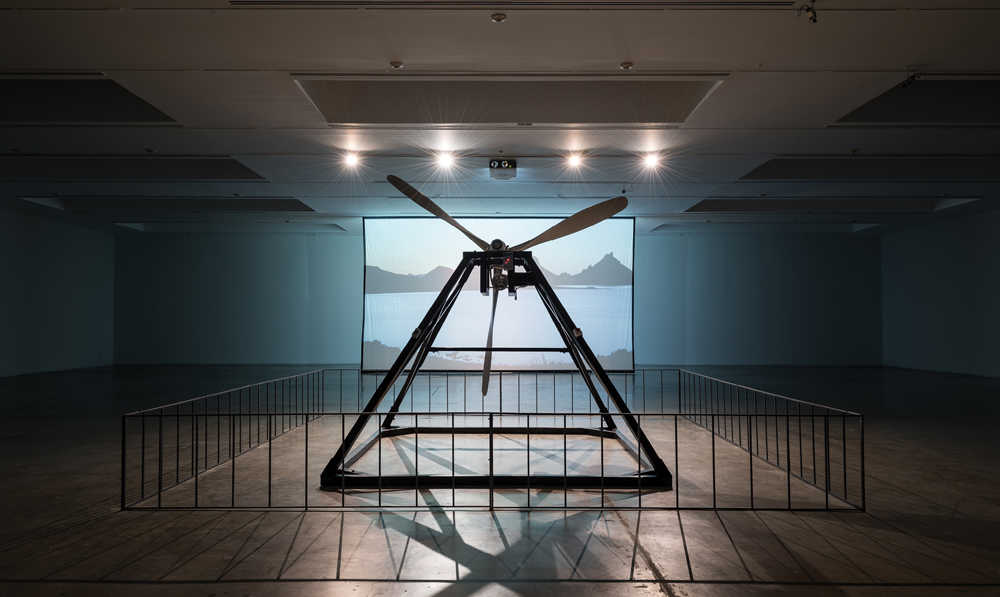 Installation view of Dodo, 2014, at Fundación Jumex Arte Contemporáneo, Mexico. Photo by Moritz Bernoully.
Installation view of Dodo, 2014, at Fundación Jumex Arte Contemporáneo, Mexico. Photo by Moritz Bernoully.
AB
Paramount Pictures had filmed for six months because they only wanted
to film between 12 and 2PM to have the brightest, burnt-out light. We
wondered what happened to the outtakes, so we contacted Paramount. It
took them about two years and then suddenly we got this email saying
they'd found a trunk of about eleven hours of film. We chose only the
nature shots, nothing to do with war. We turned a fiction film about
World War II in Italy into a nature documentary set in 1969, in Mexico.
The making of the Hollywood film had destroyed the whole coast of this
area of Mexico. So our film now depicts that.
Jumex Foundation in Mexico, where we are showing
Dodo
right now, is five hundred square meters—it's huge; over 5,000 square
feet. One of the airplane pieces we got hold of is the propeller of a
B-25. Propellers normally suck air, right? But we got it to blow air—so
we erected the propeller here (
draws a diagram of the space)
and then had our film, made of all the outtakes, playing over here. The
propeller blows the screen too, beautifully, which I love as a detail,
and then there's a whole other room dedicated to the artifacts.
SM
It sounds a bit like a drive-in movie. Your website is incredibly
self-explanatory and revealing. There are full descriptions of each
project, and one can navigate through many images and texts.
OC It's
informative.
SM Right, informative. But what about "less is more"?
OC
This is something we argue about with each other a lot: how much to
say. For us, it's an act of generosity—this is what it's about, this is
how we feel about it—but the other side of it is that we should shut up
and let people draw their own conclusions. We don't shut up very well.
AB Because we're not painters. You do need some information, otherwise the work is just absolutely meaningless.
OC But why not strike the position of the painter in relation to work that is political?
AB
My answer is that you put up a website to provide information. Why
should you be shrouded in mystery? Yet experiencing the work in the
space is an entirely different thing.
OC
But when you give your explanation, you shut down the work's ambiguity.
That is my anxiety about saying too much. Too much art jargon. Perhaps
we're more interested in the world than in the art world.
SM Does that contribute to your being so successful?
OC I don't think we are successful.
SM Guys. You can hire a team of professional archaeologists to go dig up a plane in Mexico at your whim—
OC Is that your idea of success?
SM —and you've got a work studio in the hippest part of East London, next to Brick Lane.
AB I've got a really shitty dentist.
OC I think we're restless, and the art world doesn't reward restlessness. It rewards continuity and consistency.
SM But you guys are consistently restless. What are you working on at the moment?
AB We are following up on our Bertolt Brecht project
War Primer 2. It's an unfinished opera that we are intending to finish. We are doing a first small
rendition of that in January, at the Tate.
OC Are we going to talk about the Yiddish theater?
AB Sure, why not?
OC
Just opposite the entrance to our studio was the first Yiddish theater
in Britain. There was an actor performing there called Jacob Adler who
went to America and became involved in Method Acting. His daughter
taught Marlon Brando.
SM Wait a second, Stella Adler? She's super well-known.
OC
The story of Jacob Adler is really interesting. In the late nineteenth
century there was this guy called Abraham Goldfaden who invented Yiddish
theater. Nobody had ever done theater in Yiddish before. Adler became
his principal actor. They were very successful traveling through Russia
up until the assassination of the tsar, Alexander II. After that,
Yiddish theater was banned. The actors had to escape the pogroms that
were literally happening inside the theaters, and they came to England
and formed this place—but it burned down when secular Jews and religious
orthodox Jews were fighting. So they all moved to America and became
instrumental in the development of the Hollywood studio system and
cinema acting. The directors of this Yiddish theater across the street
went on to start Metro-Goldwyn-Mayer. It's got this epic novel
feeling—from the birth of Yiddish theater to the death of Hollywood.
 From Chicago: Mini Israel #1,
2006, C-print,19 × 23 inches. The invasion of Beirut, the first and
second intifada, the Gaza withdrawal, the Battle of Fallujah; almost
every one of Israel’s major military tactics in the Middle East over the
past three decades was performed in advance here in Chicago, an
artificial but realistic Arab town built by the Israeli Defense Force
for urban combat training. Everything that happened, happened here
first, in rehearsal.
From Chicago: Mini Israel #1,
2006, C-print,19 × 23 inches. The invasion of Beirut, the first and
second intifada, the Gaza withdrawal, the Battle of Fallujah; almost
every one of Israel’s major military tactics in the Middle East over the
past three decades was performed in advance here in Chicago, an
artificial but realistic Arab town built by the Israeli Defense Force
for urban combat training. Everything that happened, happened here
first, in rehearsal.
OC We don't know yet what form it will take.
SM Full circle. What are you going to do with that epic?
AB We're still in research mode.
SM Would you ever move back to South Africa?
AB We visit, but to live, no. I wouldn't even go back there to be buried.
SM Where would you want to be buried? Or, would you like your ashes to be scattered?
AB I think that's up to whomever I leave behind.
OC We often think about that last creative act: what we'd like to have written on our respective gravestones.
AB What's yours at the moment?
OC "Dig me up and fuck me."
SM Name something you know now that you wish you'd known ten years ago?
AB That I have genital herpes? (
laughter) Promise us that's going into the interview.
OC That's gotta go in there. Keep those two jokes! -
bombmagazine.org/article/2000048/adam-broomberg-and-oliver-chanarin





